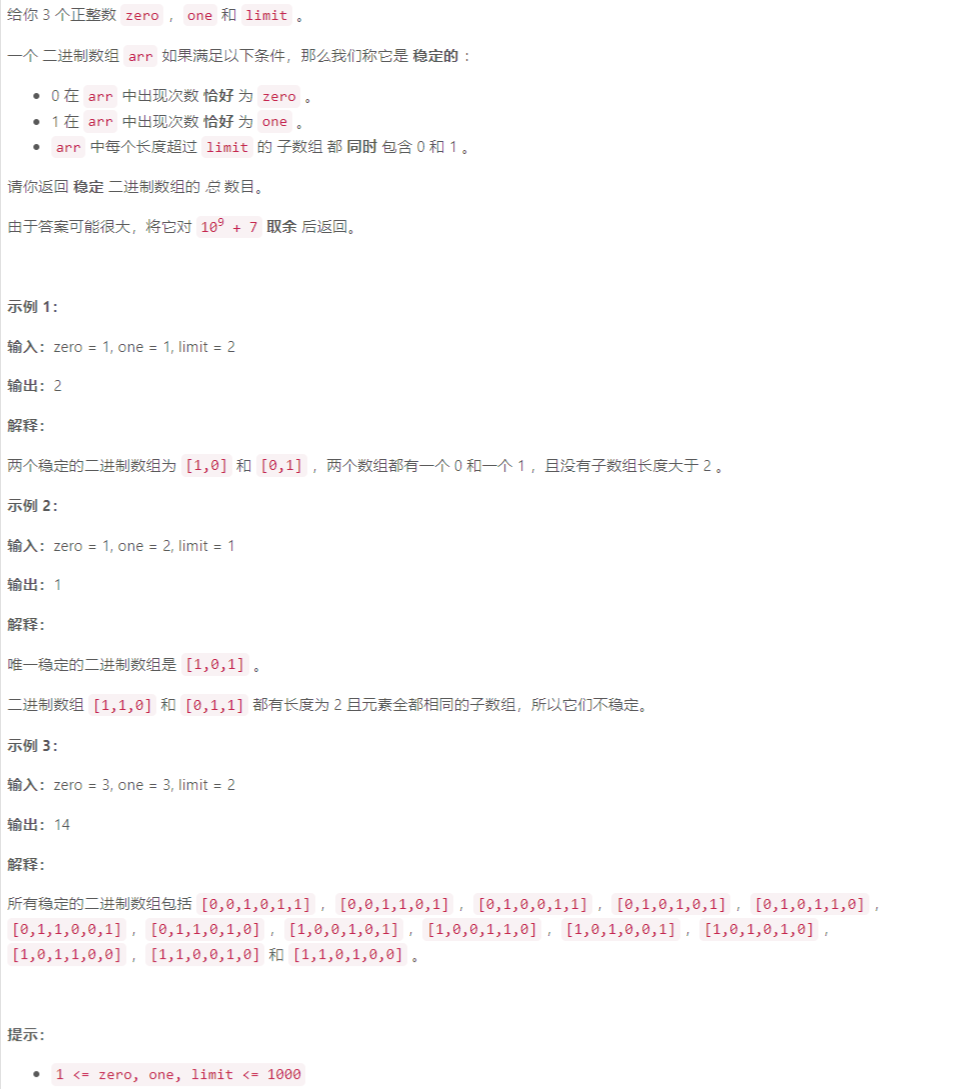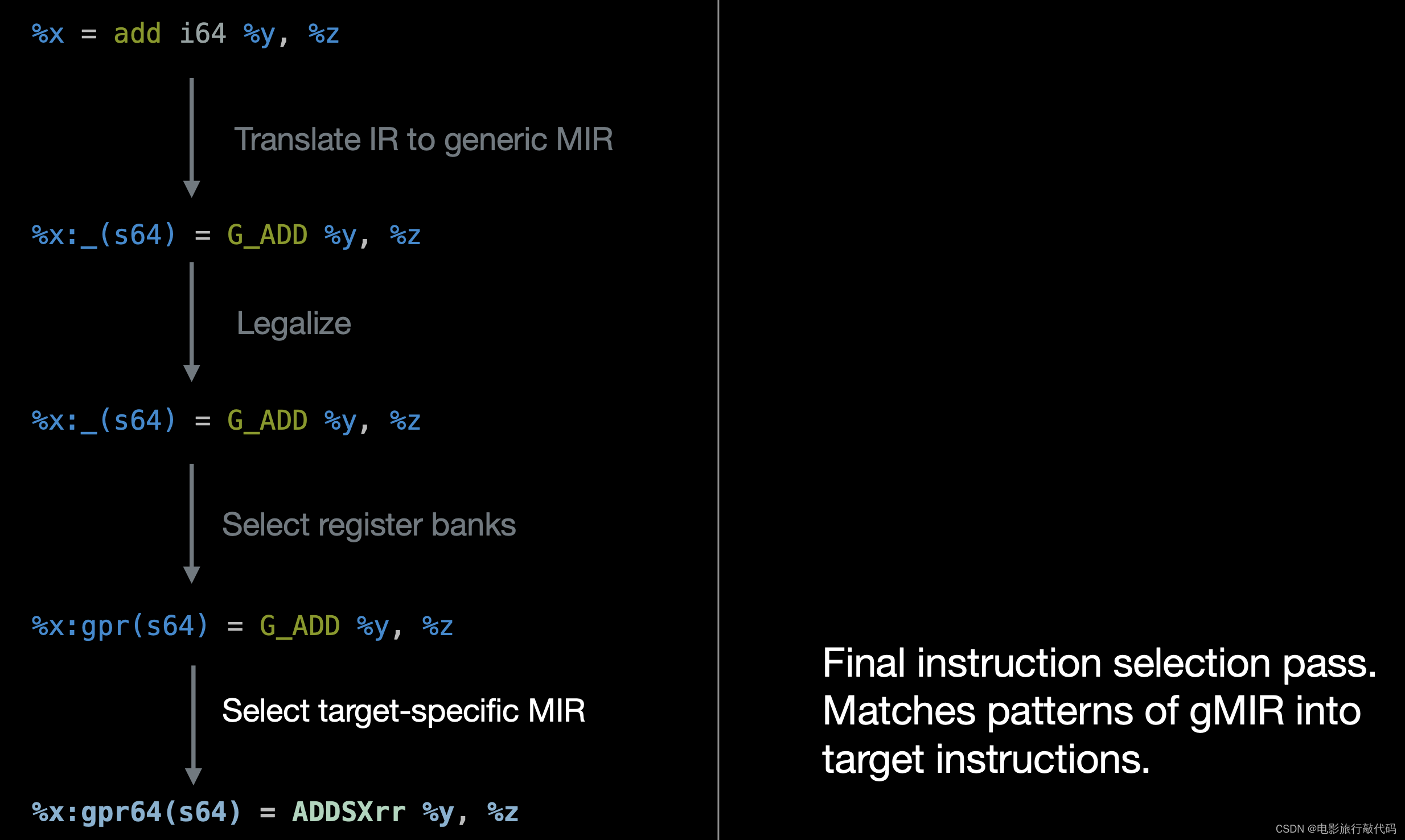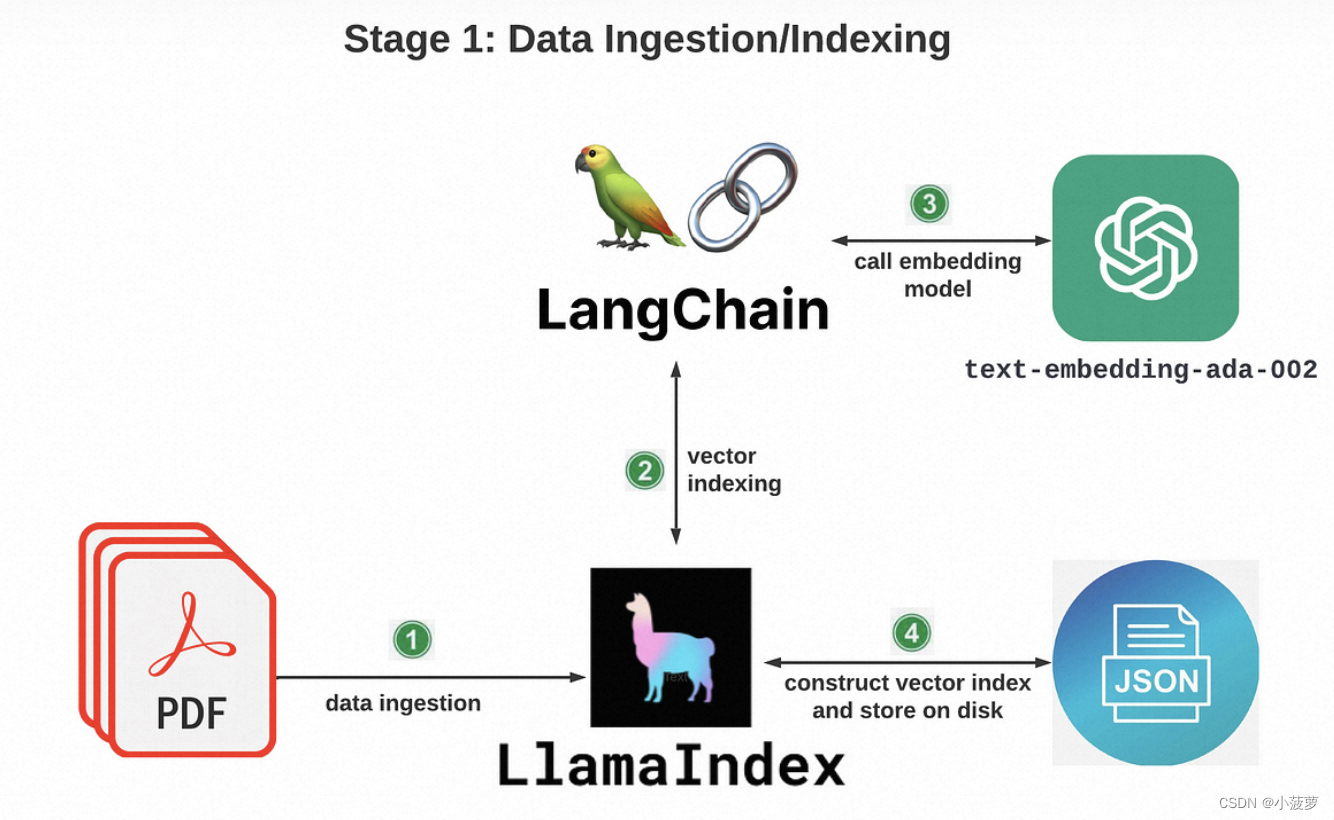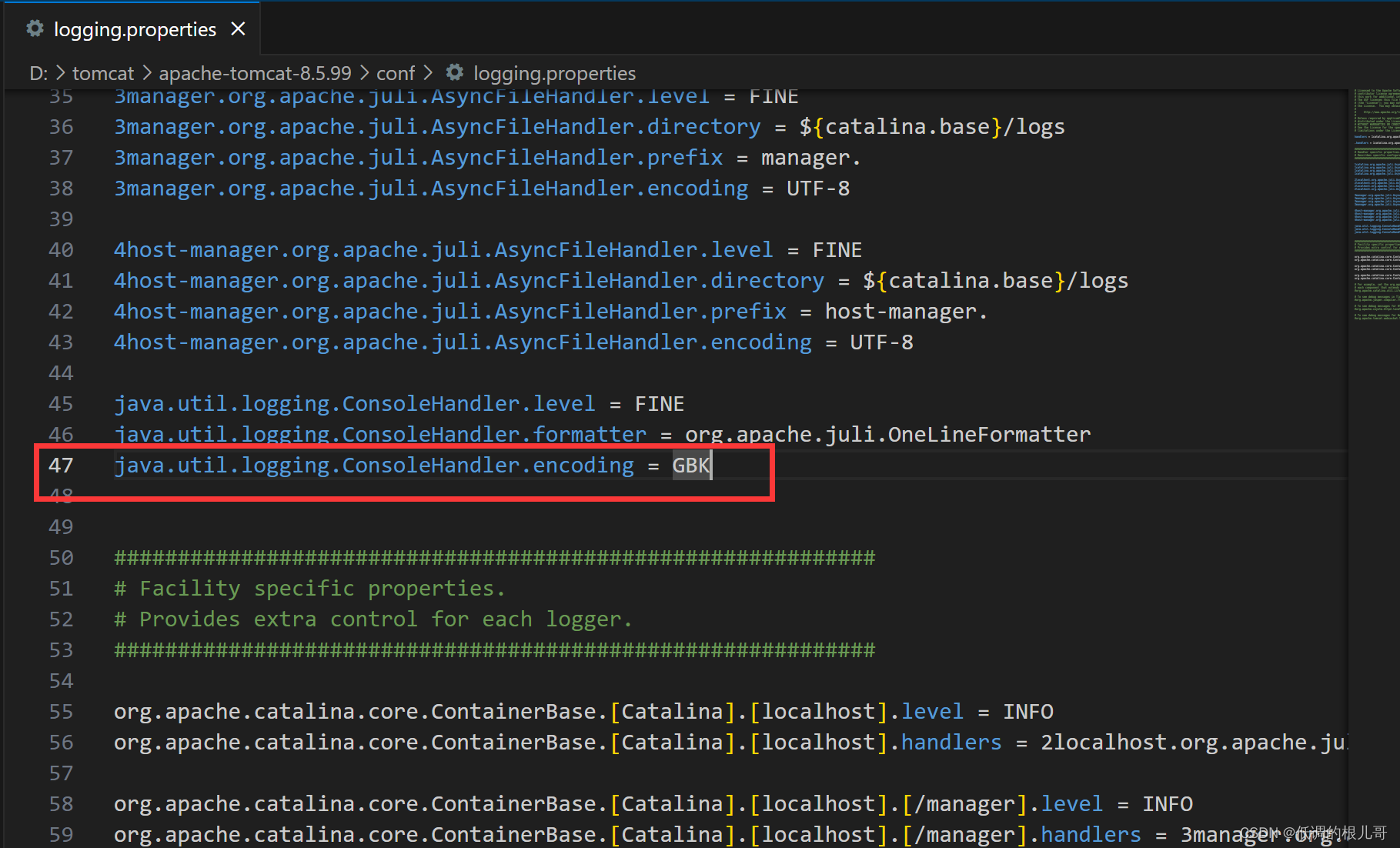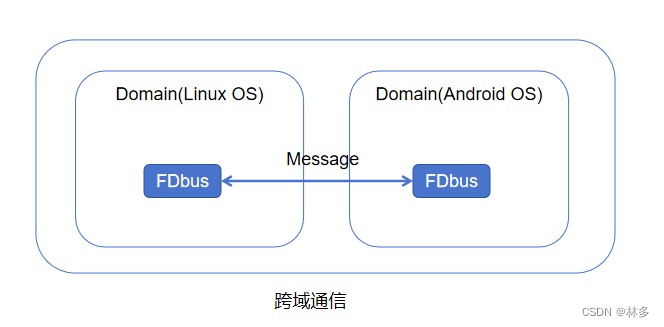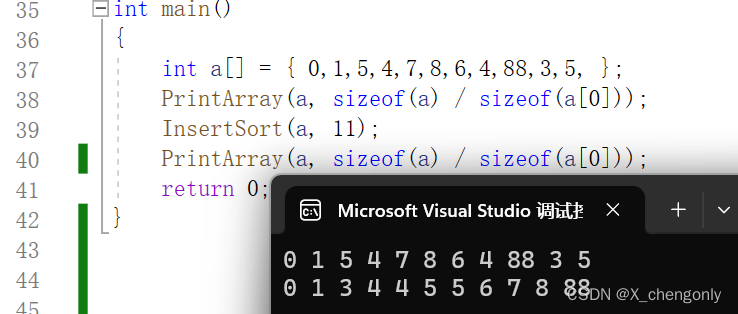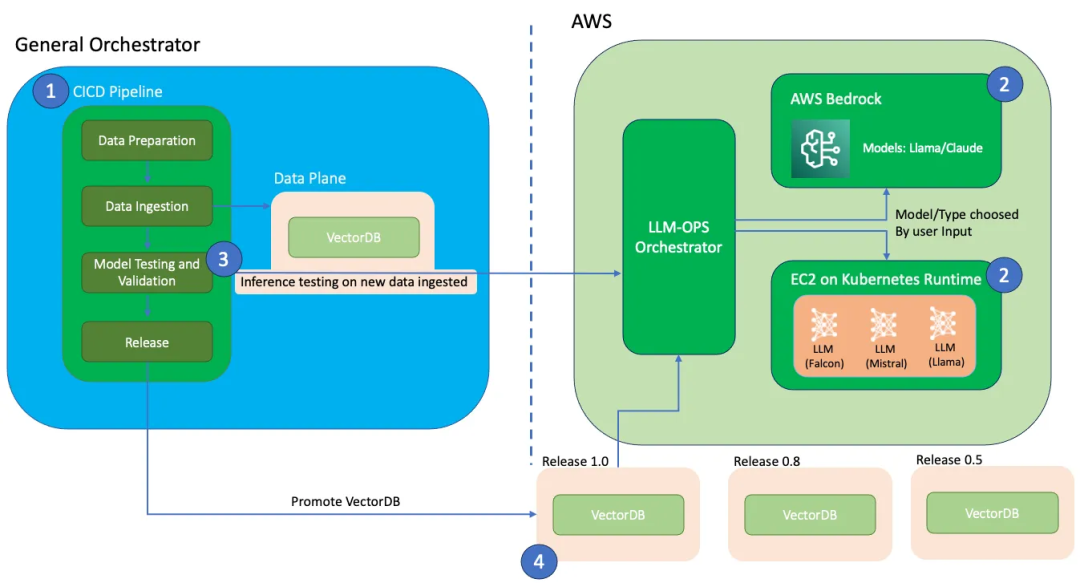An Introduction to American Law

本文是 https://www.coursera.org/programs/career-training-for-nevadans-k7yhc/learn/american-law 这门课的学习笔记。
文章目录
- An Introduction to American Law
- Instructors
- Week 05: Criminal Law
- Key Criminal Law Terms
- Supplemental Reading
- Criminal Law: Part 1
- Criminal Law: Part 2
- Criminal Law: Part 3
- Criminal Law: Part 4
- Criminal Law Quiz
- 法律英语
- 后记
Instructors
Anita Allen, Henry R. Silverman Professor of Law and Professor of Philosophy, Penn Law, University of Pennsylvania
Shyam Balganesh, Professor of Law, Penn Law, University of Pennsylvania
Stephen Morse, Ferdinand Wakeman Hubbell Professor of Law; Professor of Psychology and Law in Psychiatry; Associate Director, Center for Neuroscience & Society, Penn Law, University of Pennsylvania
Theodore Ruger, Dean and Bernard G. Segal Professor of Law, Penn Law, University of Pennsylvania
Tess Wilkinson-Ryan, Assistant Professor of Law and Psychology, Penn Law, University of Pennsylvania
Tobias Barrington Wolff, Professor of Law, Penn Law, University of Pennsylvania
Week 05: Criminal Law
In this module, Professor Morse will focus on the basics of criminal law, an area of law so exciting that countless TV shows and movies have been based on it. The major aspects of criminal law will be discussed - why we impose punishment, when we impose the most punishment, and how the state proves a criminal case. Defenses to criminal charges, which are divided into justifications and excuses will also be addressed.
Key Criminal Law Terms
Crime
Behavior that the law makes punishable as a public offense. For more, click here: http://www.law.cornell.edu/wex/crime
Criminal Law
Body of law that defines criminal offenses, regulates the apprehension, charging, and trial of suspected offenders, and fixes punishment for convicted persons. Substantive criminal law defines particular crimes, and procedural law establishes rules for the prosecution of crime. (http://www.merriam-webster.com/) For more, click here: http://www.law.cornell.edu/wex/criminal_law
Criminal Procedure
The set of rules governing the series of proceedings through which the government enforces substantive criminal law. Municipalities, states, and the federal government each have their own criminal codes, defining types of conduct that constitute crimes. For more, click here: http://www.law.cornell.edu/wex/criminal_procedure
Key Terms:
actus reus
The act or omissions that comprise the physical elements of a crime as required by statute. The statutory definition of a crime pairs actus reus with mens rea, the psychological state defining a criminal perpetrator as culpable for having committed a crime. (http://www.law.cornell.edu/wex/actus_reus)
affirmative defense
A defense in which the defendant introduces evidence, which, if found to be credible, will negate criminal or civil liability, even if it is proven that the defendant committed the alleged acts. Self-defense, entrapment, insanity, and necessity are some examples of affirmative defenses. (http://www.law.cornell.edu/wex/affirmative_defense)
American Law Institute Model Penal Code (MPC)
The purpose of the Model Penal Code was to stimulate and assist legislatures in making a major effort to appraise the content of the penal law by a contemporary reasoned judgment—the prohibitions it lays down, the excuses it admits, the sanctions it employs, and the range of the authority that it distributes and confers. Since its promulgation, the Code has played an important part in the widespread revision and codification of the substantive criminal law of the United States. (http://www.ali.org/)
burden of proof
The threshold that a party seeking to prove a fact in court must reach in order to have that fact legally established. For example, in criminal cases, the burden of proving defendant’s guilt is on the prosecution, and they must establish that fact beyond a reasonable doubt. In civil cases, the plaintiff has the burden of proving his case by a preponderance of the evidence. (http://www.law.cornell.edu/wex/burden_of_proof)
excuse
A type of defense that exempts the defendant from liability because of some circumstance, but does not actually condone the result that flowed (at least in part) from the defendant’s actions. In other words, a defendant with a valid excuse will not suffer the usual penalty for his actions, but the law “wishes” that the defendant had acted differently (as compared to a justification). (http://www.law.cornell.edu/wex/excuse)
insanity
A person accused of a crime can acknowledge that they committed the crime, but argue they are not responsible for it because of their mental illness, by pleading “not guilty by reason of insanity.” For more, click here: http://www.law.cornell.edu/wex/insanity_defense
justification
A type of defense that exempts the defendant from liability because the defendant’s actions were justified. In other words, a defendant with a valid justification will not suffer the usual penalty for his actions because in the eyes of the court, the defendant could not have been asked to act any differently in this situation (as compared to excuses). (http://www.law.cornell.edu/wex/justification)
mens rea
Criminal intent. The state of mind indicating culpability which is required by statute as an element of a crime. (http://www.law.cornell.edu/wex/mens_rea) The four mental states, in increasing order of severity, are negligence, recklessness, knowledge, and purpose/intent.
prima facie
Latin for “at first sight.” A prima facie case is the establishment of a legally required rebuttable presumption. It is generally understood as a flexible evidentiary standard that measures the effect of evidence as meeting, or tending to meet, the proponent’s burden of proof on a given issue. In that sense, a prima facie case is a cause of action or defense that is sufficiently established by a party’s evidence to justify a verdict in his or her favor, provided such evidence is not rebutted by the other party. (http://www.law.cornell.edu/wex/prima_facie)
self-defense
The use of force to protect oneself from an attempted injury by another. If justified, self-defense is a defense to a number of crimes and torts involving force, including murder, assault, and battery. (http://www.law.cornell.edu/wex/self-defense)
sentencing
A criminal sentence refers to the formal legal consequences associated with a conviction. Types of sentences include probation, fines, short-term incarceration, suspended sentences, which only take effect if the convict fails to meet certain conditions, payment of restitution to the victim, community service, or drug and alcohol rehabilitation for minor crimes. More serious sentences include long-term incarceration, life-in-prison, or the death penalty in capital murder cases. For more on this, click here: http://www.law.cornell.edu/wex/sentencing
Supplemental Reading
- “Criminal Charges: How Cases Get Started”
- “Steps in a Criminal Case: From Arrest to Appeal”
- Excerpt from Westlaw’s Black Letter Law Outline: Criminal Law
Criminal Law: Part 1
[MUSIC] Hello, my name is Stephen Morse. I’m a lawyer and professor at Penn Law
School, and I’ve been teaching and writing about criminal law for
many decades. I’m also a psychologist and a forensic psychologist, and
I’ve testified in many criminal cases. It is my pleasure to provide this
introduction to criminal law in the United States. Let’s begin. As is well known,
the American political system is federal. The states and
the federal government are independent but related entities and
each has its own legal system. There are essentially 51 sets
of criminal laws, one for each of the 50 states and
the federal government. This lecture will attempt to
provide a general overview, but you should recognize that there
may be substantial variation concerning particulars across jurisdictions. I begin by describing the nature of
law and what is distinctive about criminal law that differentiates
it from civil regulation. Then I address the justifications for state blame and punishment,
which are the touchstones of criminal law. The next section describes the harm and fault principles that guide definition
of so much of the criminal law. Following that, this lecture describes
the structure of criminal guilt, that is, how criminal liability is established. The lecture concludes by
considering sentencing.

I will also try to say what is distinctive
about United States criminal law, but United States criminal law is very
similar in most, but not all respects, to the criminal law of other developed,
post industrial countries. What is distinctive about law and
about criminal law in particular? In this section, I first offer
a simplified picture of what law is, then I turn to what is distinctive
about criminal law in particular. It is difficult to describe what
is distinctive about criminal law, without saying something about what
is distinctive about law as a way of regulating and
ordering our lives together. Consider what kinds of creatures we are. As Aristotle famously observed millenia
ago, we are social creatures, but so are ants and chimps. What is different about us, we human
beings, is that we’re the only creatures on earth that have linguistic abilities,
and are able to be guided by reasons. We have biological predispositions
like the other animals on earth, and these probably set limits. But we are the only creatures
that self consciously, and intentionally, create systems of rules and
institutions to help us order our lives by giving us reasons
to behave one way or another.
There is great diversity
among human beings and how they order their lives,
but the need for informal and formal rules to order them is universal,
to make successful human life possible. Please forgive me for using a simple and quite crude
example using ordinary language. Suppose while you are attending
some social gathering, you develop an intestinal cramp and really want to fart to relieve the
pressure, probably you won’t, but why not? After all, you’d feel so
much comfortable if you did. You won’t because there
are rules of etiquette and social norms that reject such
intentionally boorish, rude behavior for which you might be ridiculed,
criticized, or socially excluded. You won’t fart either because you agree
with the rule, have made it your own by internalizing it, or because you fear the
consequences for violating it, or both. Customs and morality are similar
sets of rules that order our lives. All these systems of rules have
their own enforcement mechanisms, again ranging from social exclusion
to criticism and condemnation. Law is yet another human intervention
of a system of rules to regulate our interpersonal life, generally, and
to moderate conflict in particular.

What is distinctive about law
however is that the creation and enforcement of legal rules is accomplished
by the state, including its near monopoly on lawful force, even when a legal
dispute is between two private parties. If the parties can not resolve
their disagreement privately, they go to law to adjudicate the conflict
and enforce the outcome if necessary. Well, all of us are acting in the shadow
of the law which gives us reason to behave one way or another. No blind instinct necessitates
adherence to the rules and indeed we often violate them. But the rules always give us explicit and
implicit reasons for action even when we habitually and
unthinkingly follow them. With this simplified understanding
of what law is in mind, let us turn to what is
distinctive about criminal law.
Let us begin with a simple, but realistic
example that is not for the faint hearted. Imagine an aggressive 21 year-old
man who enjoys driving at very high speeds on the highway,
behaving dangerously thrills him. One day he is driving at 75
miles per hour in the middle of the day on a semi-urban undivided roadway
that has one lane in each direction, a 45 mile per hour speed limit,
and intermittent traffic lights. He sees that a traffic light
up ahead is about to turn red. Although not drunk, his blood alcohol
is just above the legal limit. Instead of slowing down and stopping as he
should, the man decides to run the light for the fun of it and speeds up to more
than 90 miles an hour to make the light. Alas! The light turns red just as he
reaches the intersection and a crossing vehicle properly enters it. Our driver crashes into the hapless
other vehicle, killing the driver and paralyzing the passenger,
who is irreversibly quadriplegic. The physical evidence and
eye witnesses leave no doubt about the driver’s exceptionally
dangerous behavior and a breathalyzer test confirms that his blood alcohol
content was above the legal limit. How does united state law respond to
such an unnecessarily sad tragedy?
First, the families of the victims
could sue the driver for civil damages to compensate them for
the harm done by his negligent behavior. This is a province of tort law. The legal rules that deal with
certain types of civil harms including personal injury. This course on introduction to
law includes a module on torts. Of course, money can never replace a human
life or fix irreversible disability. But the point of civil damages is to
try and make the victims as whole as possible given the inevitable
limitations of money as a remedy. But the driver’s behavior also
manifests massive moral indifference to the rights and interests of others. It was a gross violation
of the duty we all owe each other to avoid unnecessary harms. Compelling the driver to pay money
damages seems an insufficient response. His behavior seems to call for a public response on behalf of society for
societal blame and punishment. This is the province of the criminal law. Crimes are distinct from civil wrongs
because crimes morally wrong all members of society and are prosecuted by
the state rather than by private parties. Reflecting this distinction criminal
cases are titled, not Smith versus Jones. Rather they are the titled The People
versus Jones, or the State versus Jones, or the United States versus
Jones in federal criminal cases.

Crimes or wrongs against we the people,
as well as the individual victims.
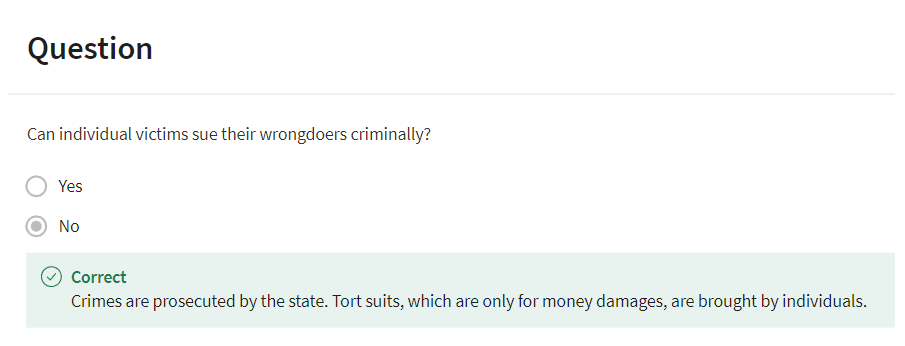
Criminal law and tort law and both methods of regulating our lives
together and they share some goals. Each involves some degree of blame and
each includes sanctions, but only criminal law is based fundamentally
on moral values about what we owe each other, and
then imposes state blame and punishment for the gross failures of
obligation that occur all too often.

State blame and punishment are the most
severe impositions of state power, because they involve official public
blame and stigma and the infliction of punishment, that is, the infliction of
pain, because the offender deserves it. Because criminal blame and
punishment are such severe inflictions, there is a different level of burden
of proof in civil and criminal law.
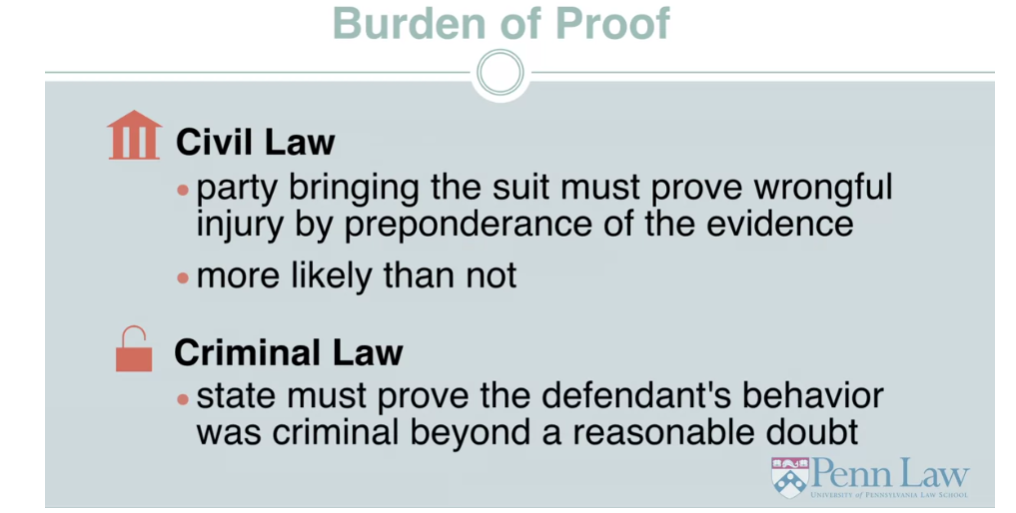
In civil law, the party bringing the suit must prove the wrongful injury by a standard known
as the preponderance of the evidence, which is interpreted to
mean more likely than not. In other words, if the evidence slightly
favors the plaintiff, that is, the party who is seeking compensation, the plaintiff
wins and the defendant must pay damages. In criminal law by contrast, the state
must prove that the defendant’s behavior was criminal beyond a reasonable doubt,
this does not mean beyond any doubt. That degree of certainty is beyond
human capacities in most cases. But before the state can impose blame and
punishment, it must demonstrate with a very high degree of certainty that
the defendant’s conduct was criminal. We impose such a high degree of burden on
the prosecution because the consequences are so potentially grave to the defendant. We favor the error of acquitting
the guilty to the error of convicting the innocent. The differing levels of burden of proof
thus reflect how much more is at stake in a criminal prosecution than
in a private civil lawsuit.
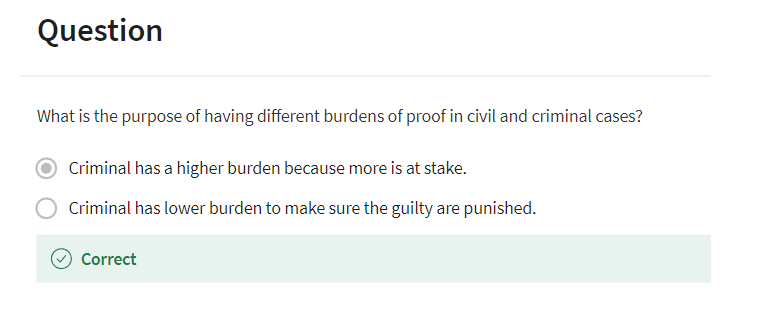
Let’s now draw an important
distinction between two ways of characterizing criminal law. The first is procedural. Those rules and
practices that guide the investigation and adjudication of criminal guilt. These rules such as the right
to remain silent and the right to be provided with
an attorney are familiar to most people. They’re extremely important and help
protect citizens from unjustified state interventions in their lives but they
are not the main subject of this lecture. Rather, in the remaining time, we’ll be talking about what is known
as the substantive criminal law. Those rules that define what
behaviour is criminal and deserves state blame and punishment.
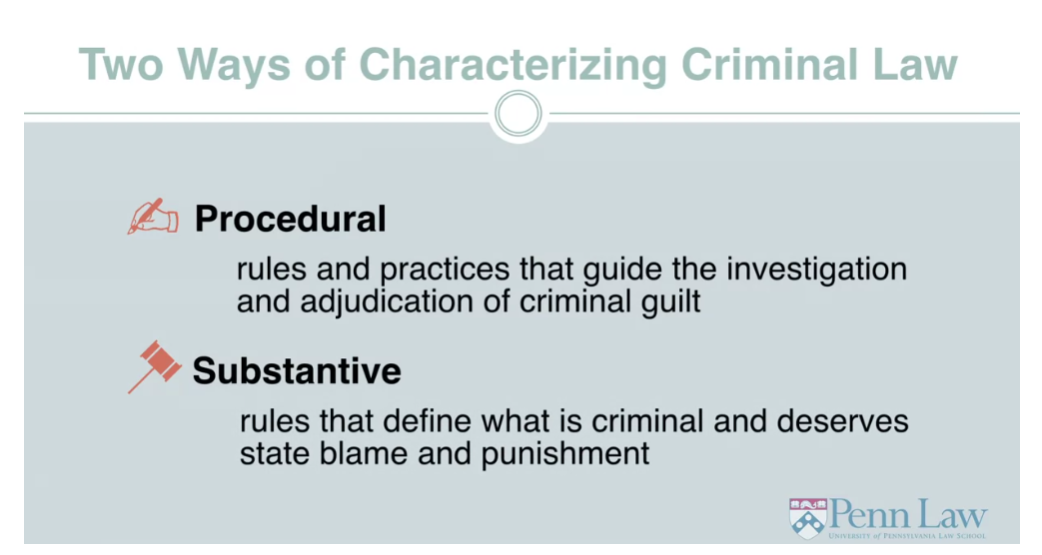
These rules are codify by the state and federal legislatures and are then
interpreted and applied by courts. In the United States, England, Canada, and
other countries originally influenced by English law, we have what is known
as a common law legal system. Judicial interpretation is far more
important to the development of the law in common law countries than in
so-called continental legal systems, and our process is considerably
more adversarial. Despite these procedural differences
however, the definitions of crimes and defenses in common law and continental penal codes are,
on the whole, remarkably similar. Most criminal cases in the United States
are disposed of by plea agreements, so-called plea bargains, by which
the defendant agrees to plead guilty, thus saving the government the time,
trouble, and expense of trials. In exchange, the prosecution usually
agrees to a lesser charge or recommends a less severe
sentence than might have been imposed if the defendant
were convicted at trial.
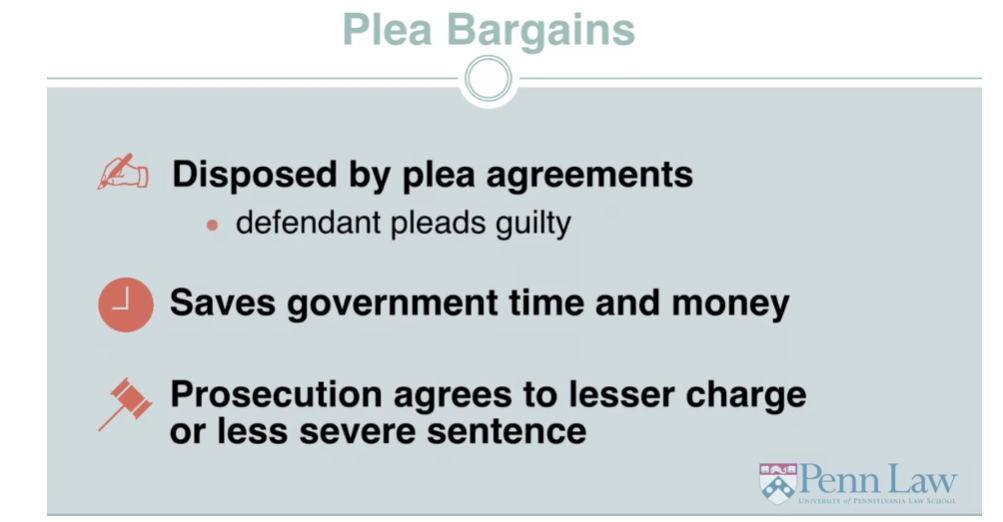
Virtually all judges routinely accept
such prosecutorial recommendations. In our system, about 98% of federal criminal cases,
and about 94% of state cases, are resolved in this way, and thus trials
are a rarity compared to peer nations. In the United States,
the rules of substantive criminal law are simply the backdrop in the shadow of
which the prosecution and defense bargain. Now, let’s talk about justifying
state blame and punishment. I have said that criminal law’s special
province is the infliction of state blame, stigma, and punishment on wrong doers. Such infliction is intentional and
thus raises the immediate question of how the state can justify
such harsh treatment. After all, intentional pain infliction morally
requires justification if anything does. What goals justify such state action? The most fundamental answers are that,
the criminal law aims to do justice by giving wrongdoers what they deserve, and
it seeks to control crime in two ways. By deterring would be wrongdoers from
committing crimes, and by imprisoning criminals who would be dangerous if
they were at large in the community. Let us consider both of these goals, giving people what they deserve and
crime control in a bit more detail.
The technical term for
the justification for inflicting blame and punishment because
the defender deserves it is retribution, which is also known as just deserts. Retribution is a theory of justice that
aims to give people what the deserve. It should not be confused with imposing
revenge, which is a common psychological desire when people have been wronged but
that is not a justification of punishment.
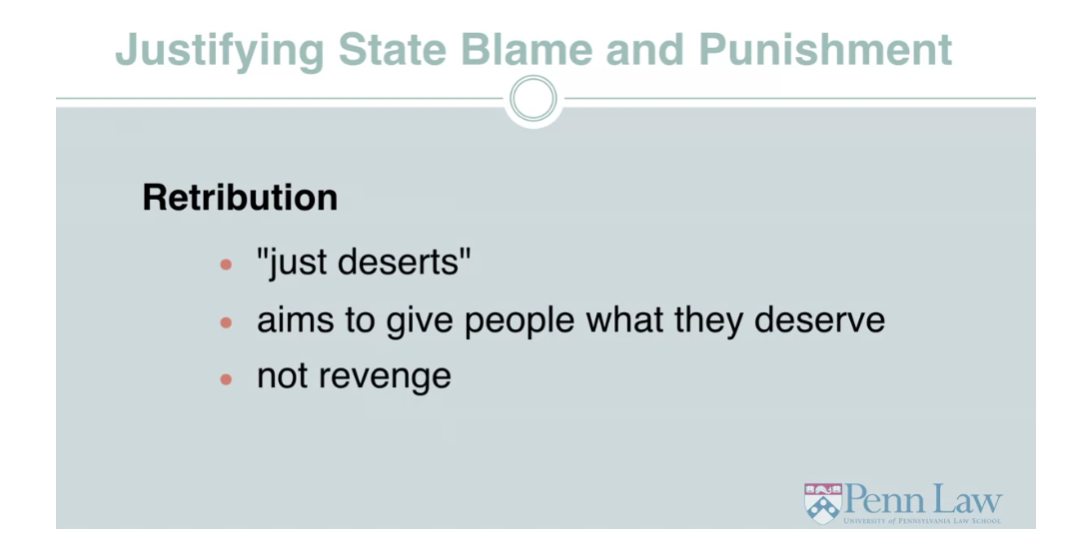
According to a retributive
theory of justice, it is simply right in itself to
give people what they deserve. Retribution is therefore, no different
from similar theories of justice in property law, in which people are thought
to deserve fair compensation for the fruits of their labor. Or contracts,
in which people deserve compensation if others break their promises. In general, in the United States we
believe that no one should be blamed and punished criminally
unless they deserved it. It would this be unfair and unjustified
to convict people known to be innocent, even if doing so
increased crime control. We also believe that people should not
be punished more than they deserve. Thus, desert is a necessary condition
before the state can impose blame and punishment and it sets a limit beyond
which punishment would be unjust. Interestingly, there is
substantial experimental and other empirical evidence to suggest that
most people are strongly disposed to blame and punish those who deserve such
treatment, even if the imposition of punishment is costly and seems to
produce no other good consequence.
The questions raised by this justification
of retribution are, when people deserve criminal blame and punishment
rather than some other response, and how much blame and punishment is deserved
for specific types of criminal conduct. Crime control is a justification
that aims directly to produce the good consequence of
cost effectively reducing crime. Although crime can be controlled by
many means other than the threatened or actual imposition of layman punishment,
such imposition may be especially effective because
the imposition is so painful. The goal is not to prevent all crime,
such a system which is anyway probably a fantasy would be
too harsh and intrusive on liberty. The question then is, when the criminal
law is the most appropriate means to control behavior consistent with
other values we endorse, such as, the right to liberty, to pursue our
projects without undue state interference and
the right to be free of blame and punishment unless they
are genuinely deserved. Although retributive and crime control goals can be complementary,
sometimes they can conflict. For example, we might believe that
a criminal defendant’s mental abnormality makes the defendant
less blame worthy because the abnormality interferes
with his capacity to use his reason. Thus perhaps, the defendant deserves
a somewhat lesser sentence than other defendants who committed the same
crime but had no mitigating condition. On the other hand, the same abnormality
might also make the defendant particularly dangerous, and thus a candidate for
even longer than usual sentence. Balancing such goals
can be a daunting task, as we shall see when we
discuss sentencing later. This is a good time to take a break,
when we continue, we will turn to the principles that
guide the definitions of crimes. [MUSIC]
Criminal Law: Part 2
[MUSIC] With the goals of criminal law that
we discussed before the break, retribution and crime control, in mind. Let us turn to how society
defines criminal behavior. It is often said that the entire body of criminal law can be
described by two principles. The harm principle and
the fault principle.
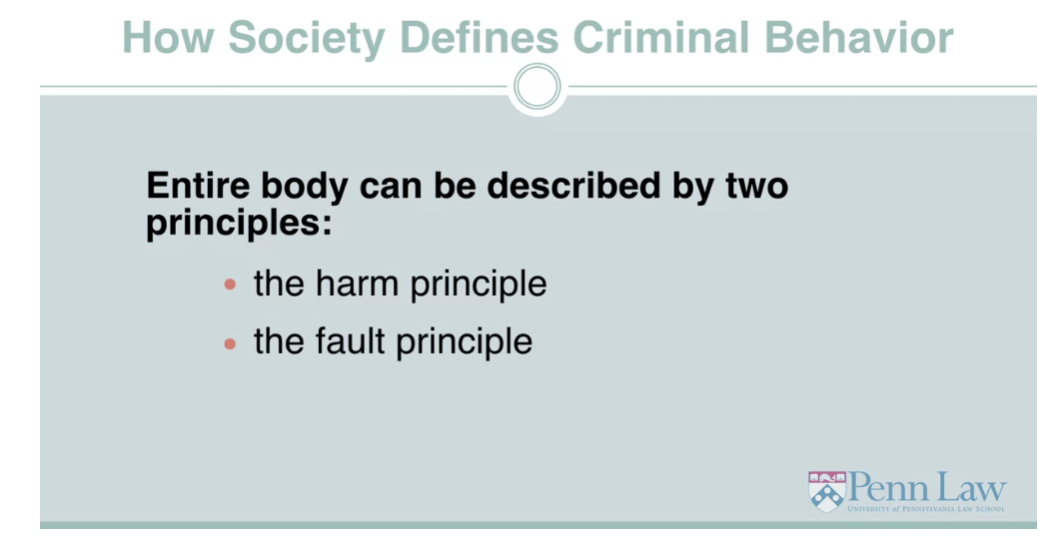
The harm principle tries to pick
out those behaviors that produce such substantial and unjustified harms,
or such risk of harm, that the criminal law is
the appropriate response. Some harms,
such as the use of force, theft, and fraud are the so
called core of the criminal law. Familiar examples are homicide, rape,
arson, and stealing another’s property. They involve substantial harm to others,
and their prohibition is uncontroversial and found in all
mature systems of criminal law. In the last century however, and
increasingly in recent decades. Criminal law is used to address
a wide variety of potentially problematic activities that are none
the less not obviously sufficiently clear violations of the duties we owe each other
to warrant societal blame and punishment. For example, do you think that a person
should be convicted of a crime and sentenced to prison for passing oneself off as the war hero by
wearing medals the person did not earn? It’s insensitive and immoral behavior
like intentional emotional cruelty, but should it be regulated with criminal
law and potential imprisonment? Congress thought so and
passed the stolen valor act of 2013, which the President signed into law. Should prostitution be a crime? Or should it be dealt with by
public health measures and other forms of non criminal regulation? Such expansive use of the criminal
law is controversial. Because it is not clear that
criminal law regulation is morally appropriate and necessary. And employing the criminal law
when it is not appropriate, and not necessary tends to undermine
the moral message that the criminal law distinctively is meant to convey.
A current example of the issue of
the appropriate use of the criminal law is the extensive law enforcement
approach to branding the use recreational use of abusable drugs, other
than alcohol and nicotine, of course. There’s substantial debate about
whether criminal law regulation as the primary means to prevent drug use
is a wise and cost effective policy. More generally, criminal law as a
regulatory tool, has become so expansive. That is unclear that the harm
principle is now use to limit the proper reach
of the criminal law. It is often said that our Federal
system provides 51 laboratories, the 50 states, and the Federal Penal Code
for trying to produce the best policies. This permits substantial experimentation
and responsiveness to differing values and attitudes in different jurisdictions
rather than a one size fits all approach. Moreover in our legal order,
the Constitution places almost no limits on the ability of a jurisdiction
to criminalize an activity. That is, the various states and the federal government have essentially
no restrictions on the type of conduct within their jurisdiction, that
they can prohibit using the criminal law. Exceptions are infrequent,
are never usually based on a conflict between the prohibition and
another constitutional value.
To return to the example of the stolen
valor act raised shortly ago. The Supreme Court found an earlier version
of the act that prohibited lying about military heroics unconstitutional, because it violated the First Amendment’s
protection of free speech. Otherwise, it would have been perfectly
acceptable to criticize such unsavory, but not terribly harmful behaviour. Another unusual example, is a case in which the Supreme Court held
that it was unconstitutional to blame and punish a person simply for
the status of being a drug addict. Not for use, not for
possession, but simply for the status of being a drug addict. Because statuses are not actions. They are not behavior and thus they
are beyond the reach of the criminal law. But such instances are indeed unusual.
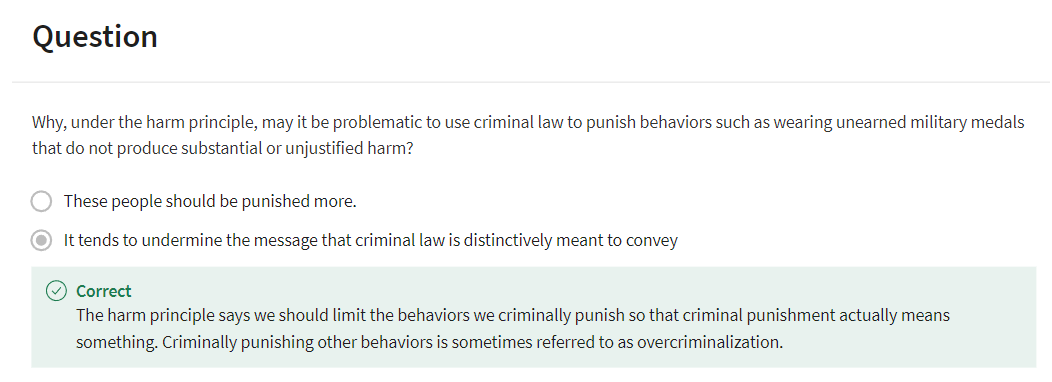
Despite the variation that our
federal system permits there are none the less substantial similarities
among the various criminal codes, that they all start from similar legal and
cultural heritage. Now let us turn to the fault principle. This is the principle that guides
who deserves criminal blame and punishment for the behavior that we
wish to prevent using the criminal law.
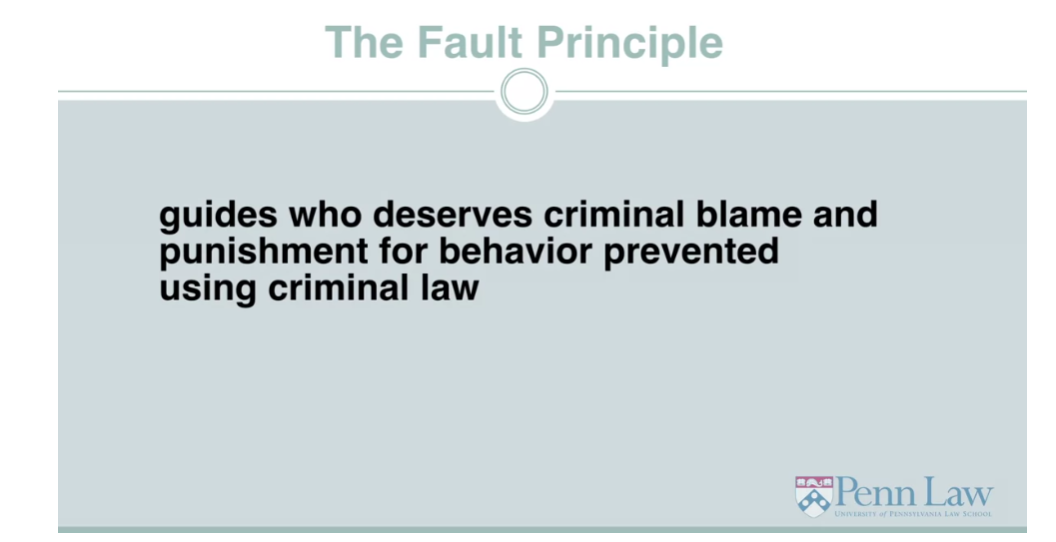
Examples of such behaviors are killing
conduct, non-consensual sexual contacts, burning of buildings,
takings of another property, and the like. All these harms can be caused
without fault if a person was acting as carefully as one could
expect under the circumstances, but caused an accident nonetheless. Accidents happen without fault. Indeed, the only way to prevent all
accidents would be to completely cease all interpersonal human interaction. When innocently cause harms occur
such cases are occasions for regret, but hardly for
criminal blame and punishment. Indeed if the harm doer, and
note that I say harm doer and not wrong doer was sufficiently
careful victims of the accident would not even
be entitled to tort damages. Because the harm doer did not
violate the reasonable standard of care that is the touchstone
of tort liability. So if causing a harmful result by one’s
behavior is not a sufficient condition for blame and punishment, what is
the essence of the fault principle? We can best start to explore
this question with a quote from former Supreme Court Justice
Oliver Wendell Holmes. Justice Holmes wrote that even a dog knows
the difference between being stumbled over and being kicked.
Just so the law and ordinary morality,
I should add, assess for not just on the basis of results or
outcomes of our behavior, but more importantly on the basis of the
mental state with which the person acted. An intended harm,
a violent kick of an enemy is vastly more blameworthy than an accidental kick
that is equally painful to the victim. Mental states are the royal
road to moral fall.
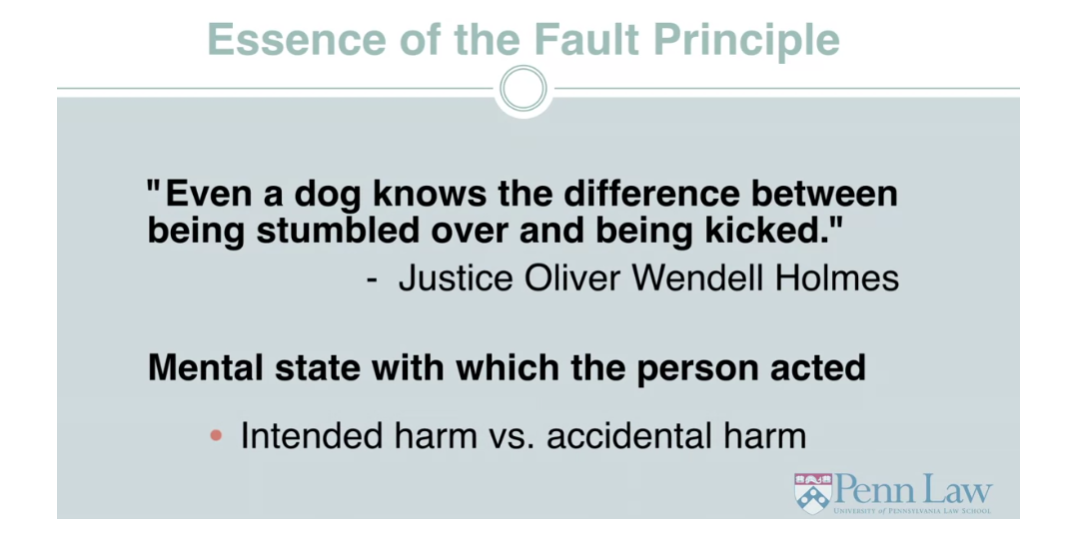
The mental state with which a person
engages in potentially harmful behavior is the best indication of the
person’s attitudes towards the rights and interests of fellow people. If someone is being as careful as
humanly possible, then the person has manifested complete respect for
the rights and interests of others. If the person has intentionally caused
the harm without any justification then the person has demonstrated
that the rights and interests of the victim do not matter. Such indifference is the essence of
moral fault and blameworthiness. The mental states that make conduct
criminal violations are knows as the mens rea. This is an old Latin term that
literally means a guilty mind. But this is misleading. A more precise meaning would
be the mental state that is part of the definition that makes
a specific behavior a crime.
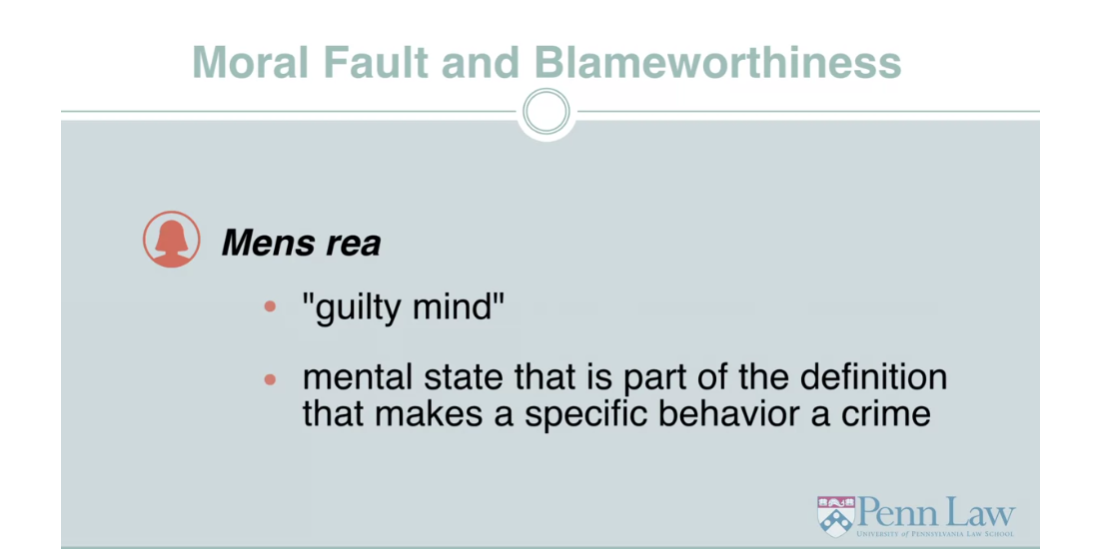
There is nothing problematic
about forming intentions. We do it unproblematically all the time. I am intentionally
delivering this lecture and you are intentionally listen,
listening to it. But there is nothing criminal about
delivering or viewing an academic lecture. But as we just saw,
the mental states that accompany various potentially harmful behaviors distinguish
how blameworthy the person is. Is the combination of acting in prohibited
ways coupled with a mental state indicating culpability that
are the pre-conditions for fault. The criminal law is littered with
mental state terms that are parts of the criteria for crime. Often such terms are confusing. But, in the last half century, a law
reform organization based in Philadelphia, the American Law Institute,
has published a model penal code that identifies blame worthy
mental states with some care. Although it is only a model code, and
it is not binding on any jurisdiction,. It has had enormous
influence on the reform and evolution of criminal law, since it
was published in the early 1960’s. It identifies four culpable Mental States. Purpose, Knowledge,
Recklessness, and Negligence.
这四个概念是在法律领域中用来描述不同的心态或心理状态,涉及到罪责和过失程度的判断。下面是它们的区别:
-
Purpose (Purposefully / Intentionally):
- 意图:这意味着行为者有目的地、故意地进行某种行为,他们有明确的目标,希望实现某种结果。
- 例子:一个人故意偷窃,他们明确知道他们在做什么,并且故意选择违法行为。
-
Knowledge (Knowingly):
- 知情:这表示行为者知道他们正在做的事情,他们知道自己的行为可能会导致某种结果,即使他们没有明确的意图。
- 例子:一个人购买了被盗窃的物品,他们知道这个物品可能是被盗的,但他们并没有直接参与盗窃行为。
-
Recklessness (Recklessly):
- 鲁莽:这指的是行为者明知自己的行为可能会造成危险或损害,但他们故意忽视了这种危险,继续进行行为。
- 例子:一个人在酒后驾车,明知这样做可能会导致交通事故,但他们选择继续驾车。
-
Negligence (Negligently):
- 疏忽:这表示行为者没有尽到必要的注意义务,他们在某种程度上没有采取合理的预防措施,导致了某种损害或不良结果。
- 例子:一个商家没有及时清理地面上的水渍,导致顾客滑倒受伤,这是因为商家疏忽没有采取必要的安全措施。
总的来说,这些概念代表了法律中不同程度的故意和过失,对于确定罪责和法律责任非常重要。
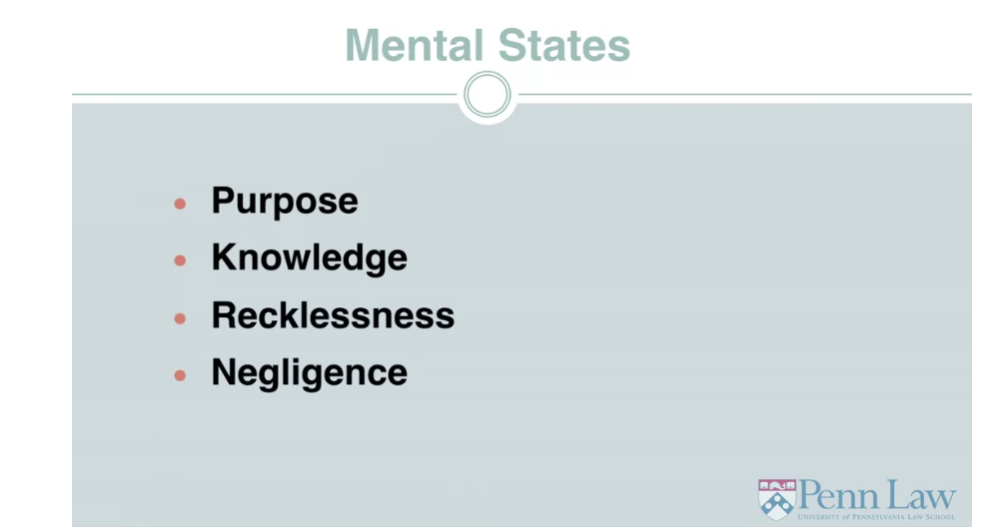
Let me use an oversimplified example
of homicide to define them for you. Purpose has it’s ordinary
language meaning. That is, to do something on purpose. The result is your conscious goal. So if I kill purposely, this means
that I meant to kill the victim, I did it on purpose. Knowledge means simply that
you are aware of some fact, or practically certain that it is true. Suppose for example I want to blow
up a plane to destroy the cargo so that I can collect insurance proceeds. The crew, of course,
dies in the explosion. Was it my true purpose to kill them? Not necessarily, I may even have foolishly
hoped that a miracle would occur, and that they wouldn’t die. Nevertheless, I knew it was practically
certain that the crew would die and I would be guilty of knowing homicide. To define the other culpable mental state
terms, recklessness and negligence. Let us return to the example of
our speeding driver which this lecture used earlier. The driver certainly did not have
the goal that someone should die and he was not practically certain that
someone would be killed as a result of his enormously dangerous driving. But he created an immense
amount of risk of death. That was completely unjustified
under the circumstances. Recklessness means that the person is
actually aware of a risk he is creating. It is actually in his mind, but he decides to run that risk
despite recognizing the danger. The driver would thus be guilty
of reckless homicide if he was actually aware of the risk of set,
of death or serious bodily injury, but he decided to run the light anyhow for
no reason with any social justification.
Negligence is defined as being unaware
of a risk a person has created. But under conditions in which a reasonable
law abiding citizen should have been aware of the risk. The person that’s failed to pay
the kind of attention we expect of each other when creating
unjustified risks. Even if our driver was somehow
not aware of the risk of death or serious bodily harm he was
creating by his dangerous driving. He certainly should have been aware. In criminal law, the amount of
risk that must be created for criminal liability is greater than in
tort law, reflecting the criminal law’s concern with sufficient culpability to
justify, state blame, and punishment. Remember that I said that the mental
mental state accompanying behavior is an indication of the person’s
attitudes towards the rights and interests of others who might
be effected by the behavior. The more indifferent someone is,
the more blame worthy. And they are almost certainly more
dangerous if they are more indifferent.
The four mental states I have defined,
purpose, knowledge, recklessness, negligence,
represent an imperfect, but good hierarchy of different
levels of blame worthiness. To continue the homicide example,
killing purposely or knowingly is more indifferent and
generally more dangerous than killing by the creation of risk with
awareness of the risk. Which is in turn more blameworthy than
killing without awareness of risk, but one, but when one should
have been aware of the risk. And the severity of punishments that may
be imposed reflect such different levels of blame worthiness, even when the result,
such as death, is the same.
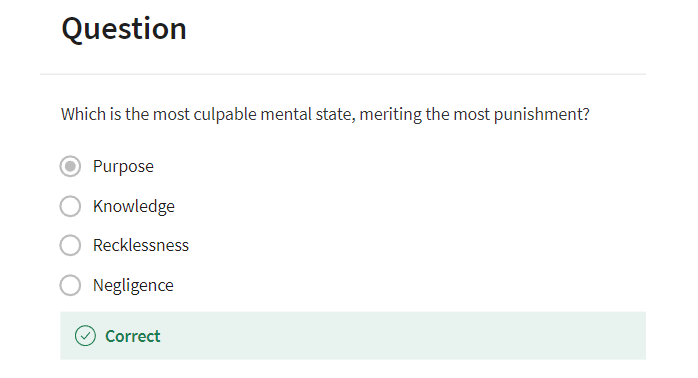
There is one major exception to
the full principle in the United States criminal law. So called crimes of strict liability. These permit criminal blame and punishment, simply for engaging in
the preminal, in the prohibited conduct. Even if one’s behavior was blameless. For example, shipping certain goods
in interstate commerce without a proper label may be a crime. Imagine a midsize business
that is a wholesaler and distributer of pharmaceuticals. The firm packages and
labels the drugs before shipping them. Suppose one batch is not properly labeled, all though the firm management had
instituted exceptionally fine training and quality control for the labeling
process there is no perfect process. Innocent accidents happen, and the
business and it’s officers are blameless. Depending on the circumstances the
officers and perhaps the business itself are nonetheless criminally liable,
and may be blamed and punished. Such crimes largely
address public health and safety issue and carry light
punishments and stigma, but not always. Some strict liability crimes
carry heavy penalties. Such crimes, and there are many,
many in contemporary criminal codes. Are extremely controversial
because they potentially blame and punish people engaging in legitimate
activities in blameless fashion.

Given the immense importance of fault in
criminal law, the question is whether it is fair to use the criminal
law to regulate such behavior. Especially since other forms of
regulations such as civil fines might be equally effective. Having considered the harm and fault
principles that guide the definition of crime, we will turn to the actual
structure of criminal guilt after a break. [MUSIC]
Criminal Law: Part 3
[MUSIC. Welcome back. Let’s begin this section with
the discussion of the structure of criminal guilt. That is, how the state
establishes criminal liability. The structure of guilt, criminal guilt,
includes what is known as the prosecution’s prima facie case, and
what are termed affirmative defenses.
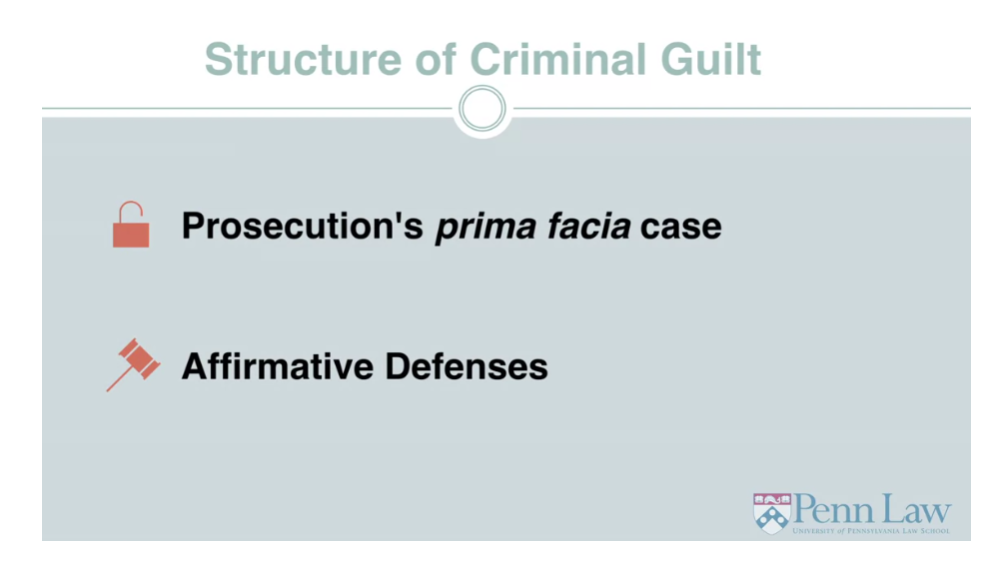
“the prosecution’s prima facie case” 意指检方所提出的“初步证明案件”,在法律上指的是检方提出的足以支持对被告提起指控的证据和事实。这种证据足以在未经证实的情况下建立对被告的责任或犯罪嫌疑,而不需要进一步的证据或推论。
换句话说,如果检方能够提出足够的证据来建立案件中所指控的事实,以至于在合理的推论下可以认定被告有罪或有犯罪嫌疑,那么就可以说检方已经建立了"prima facie case"。这并不意味着被告被正式定罪,而是表明有足够的证据将案件提交给法庭审理,让法官和陪审团进行进一步的审判和裁决。
At first I’ll be speaking
rather abstractly, but don’t worry,
I’ll soon give concrete examples. The definitional criteria for
culpability for criminal offenses are what lawyers
call the elements of the crime. They are typically defined by statute, although courts may later interpret
the meaning of these criteria. These elements are known
as the prima facie case. The constitution requires
that the prosecution must prove the definitional elements of
an offense beyond reasonable doubt. If the prosecution cannot prove any one
of the elements of the charged crime, the defendant will be
acquitted of that crime. Although the defendant may be
guilty of some other crime, for which the prosecution can
prove all the elements. If the prosecution can
prove the prima facie case, all the definitional elements of
the crime beyond a reasonable doubt, the defendant will be guilty unless,
and it is a very big unless, the defendant can establish what is
known as an affirmative defense. Affirmative defenses are also
defined by their elements.
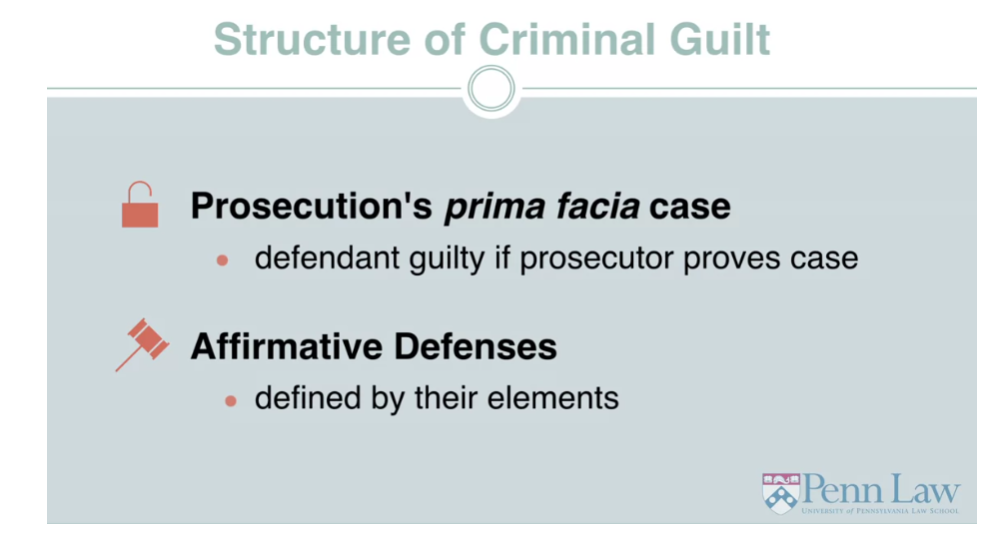
“Affirmative defenses” 是指被告在法庭上提出的一种辩护手段,用于否认或减轻被指控的罪行。与一般的否认辩护不同,肯定辩护要求被告提供额外的证据来支持其辩护。
举例来说,如果被控犯有盗窃罪,但被告声称自己行为是为了保护自己或他人的财产,这就是一种肯定辩护。在这种情况下,被告需要提供证据来证明自己的行为是合理的、必要的,并且符合法律规定的辩护条件。
肯定辩护通常要求被告提供证据来支持他们的主张,而不仅仅是对控方提出的指控进行否认。在一些司法体系中,如果被告成功地提出了肯定辩护,法庭可能会撤销对其的指控,或者降低其所面临的刑罚。
Even if the defendants conduct
met the prima fascie case, the defendant will avoid guilt if
an affirmative defense is established. The United States Constitution permits
placing the burden of proof for affirmative defenses on the defendant
if a jurisdiction wants to do this, and many do for some affirmative defenses. In some, criminal guilt requires
proof beyond reasonable doubt of the prima facie case, and the failure
to establish an affirmative defense. Guilt is avoided, the defendant will
be acquitted and legally innocent of the crime charged, if either
the prosecution cannot prove the prima facie case beyond a reasonable doubt or
an affirmative defense is established.
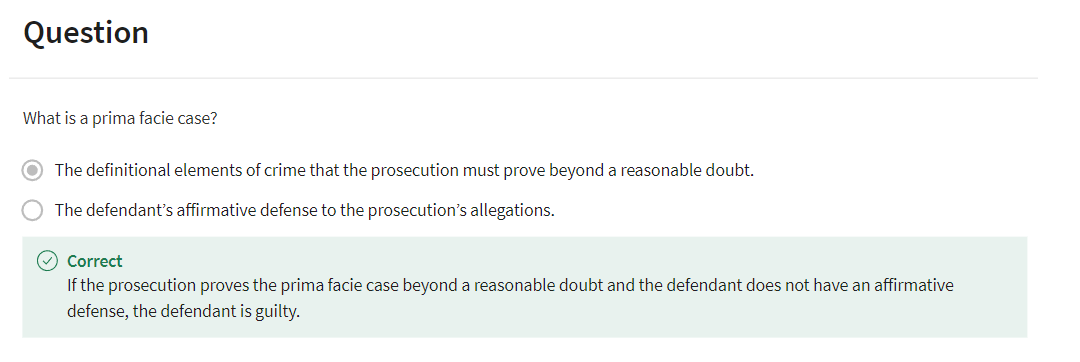
Let us now use a concrete
example based on a real case, Clark versus Arizona, that reached
the United States Supreme Court. Eric Clark was riding in his
pick-up truck in Flagstaff, Arizona when he was stopped
on a routine traffic stop by officer Jeffrey Moritz who was in full
uniform and driving his police cruiser. The stop quickly turned deadly
as Clark shot and killed Moritz. Clark was charged with
the murder of a police officer. In Arizona, the crime was defined
as follows, intentionally, or knowingly killing a law
enforcement officer, who also had to be a person,
obviously, in the line of duty. Note that this particular form of homicide
focuses on the identity of the victim. It carries enhanced penalties because we
believe that killing an official member of the government,
who serves to protect all of us, is more serious than the already
serious killing of a civilian. Thus, such defendants are more culpable
if all of these elements are proven, and we want to deter such conduct
with higher penalties, especially to protect police officers. Thus, the prosecution’s case was
to prove that Clark killed Moritz, that Clark killed Moritz purposely or
knowingly. And that Clark knew that
Moritz was a human being and a police officer acting
in the line of duty. But even if the prosecution was able to
prove this prima facie case, suppose Clark killed because someone threatened to
kill him if he didn’t kill Moritz. Or suppose Clark suffered from
a sever mental illness, and delusionally believed that Moritz
was about to kill him, Clark. In either case,
maybe Clark shouldn’t be found guilty. Even if the prosecution can prove that he
intentionally killed a police officer, knowing he was a police
officer in the line of duty.
We shall use this example as we
examine the prima facie case, and affirmative defenses in more detail. In this section I will discuss each
type of element in the definition of a crime and how the defense can try to
show that the element did not exist, and thus that the element is innocent of
the crime requiring that element. Each crime includes a conduct element,
a prohibited type of intentional behavior.

In the Clark case, the conduct is any
type of intentional killing conduct. So, it wouldn’t matter if Clark
intentionally shot Moritz, stabbed him, bludgeoned him, strangled him,
or pushed him off a cliff. This requirement that the defendant
intentionally engaged in prohibited conduct is known
as the act requirement. After all, if the defendant’s bodily movement was not
an action, how can we blame the defendant? Suppose for example after
the traffic stop, Clarks, Clark and Moritz were talking about the ticket. Suddenly, as a result of an unforeseeable
neurological event, Clark’s arm spasmed! And struck Moritz in the head,
killing him. We would say in such cases that
Clark didn’t act at all, and can’t be blamed for Moritz’s death. In our actual case, there is simply no
reason to believe that Clark shooting at Moritz wasn’t an intentional action. So the prosecution will have little
trouble proving the act requirement.
As we saw, mental states
are the primary fault criteria. Guilt under the homicide statute
in Clark requires that when Clark intentionally shot at Moritz, he did
so with the purpose of killing Clark or knowing that a gunshot was
practically certain to kill him. This looks like another easy win for
the cross persecution, but Clark undisputedly suffered
from paranoid schizophrenia. There was evidence they had delusional
beliefs that space aliens were persecuting them. Clark claimed that he genuinely
believed that Moritz was a space alien. If we believe him, then he did not
purposely or knowingly kill a human being. His purpose or
knowledge concerns space aliens, and killing a space alien with any
mental state is not a crime. At least not yet. Clark also had to know that a particular
so-called circumstance element existed, namely that Moritz was an officer
acting in the line of duty. But even though Moritz was in uniform and
in a police cruiser, if Clark genuinely believed he was a space
alien impersonating a police officer, then Clark really didn’t know Moritz was
an officer acting in the line of duty. Indeed, if he really had this belief, he wouldn’t be guilty of reckless
homicide, because he was not aware that he was risking the life of a person by
shooting at a supposed space alien. At most, he would have been guilty
of negligent homicide because he made an unreasonable mistake
about the nature of his victim. A reasonable person would have been aware,
as Clark arguably was not, because he was acting under
the influence of a delusion, that Moritz was a person and
police officer, and not a space alien.
There are other elements the prosecution
must prove to establish guilt for criminal homicide. And there are many ways other than
introducing mental disorder evidence, that a defendant can try to cast
reasonable doubt on the elements of the prosecution’s prima facie case, but
I’m sure you get the general picture. In the event,
this case was tried before a judge. Clark waived his right to a jury
presumably because he thought a judge, who on average is more highly educated
than a juror, would better understand and sympathize with expert psychiatric or
psychological testimony. But the judge thought that the prosecution
had proven that Clark knew that Moritz was a person and a police officer, and
that Clark had killed Moritz on purpose. Thus Clark,
Clark was prima facie guilty, and would be convicted of murder unless he was
able to establish an affirmative defense.
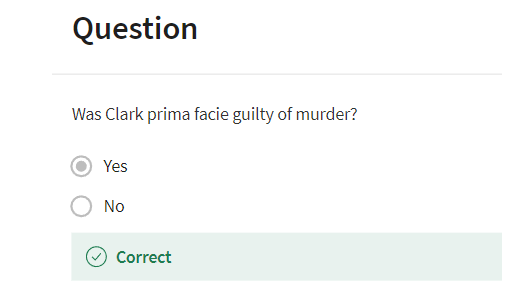
Let us now therefore turn to
understanding the affirmative defenses. In essence,
the elements of the prima facie case do not require proving why a defendant
acted as he or she did. It is simple prima facie wrong, for example, to kill another
human being intentionally. If you do that,
you are prima facie guilty of murder. But we all understand from our ordinary
experience that people sometimes do things that at first appear wrong, but then, when
we understand why the person did them, we may think that it was
not wrong after all. Or, even if we think that it was wrong,
we may think that the person was not blameworthy because there was
something amiss about the defendant, or the situation. There are two classes of
affirmative defenses. Justifications and
excuses that follow from these observations that sometimes these things
that appear wrong, may not be wrong. And sometimes the person who does wrong,
may not be a responsible person.
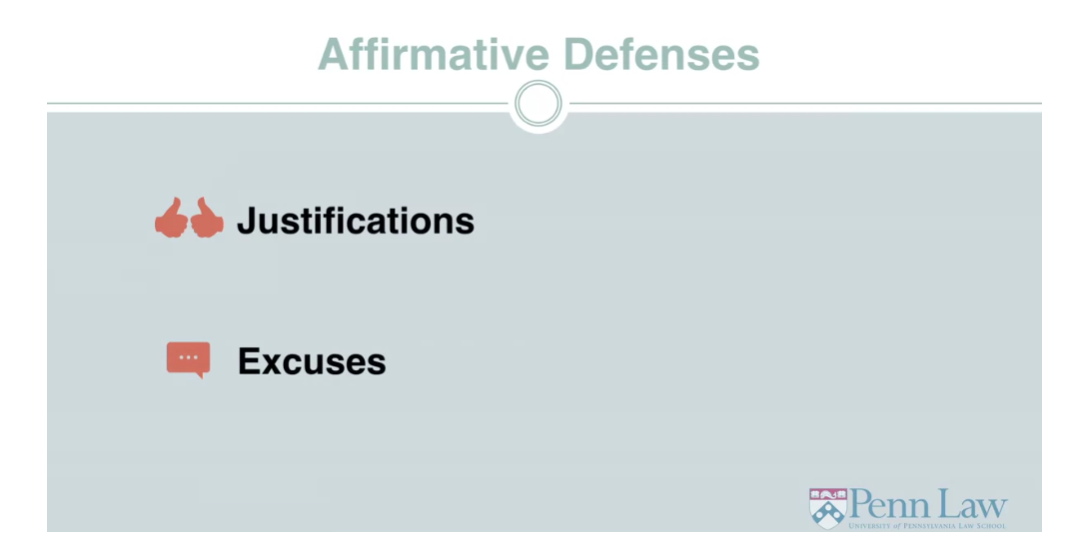
Let us consider them in order,
beginning with justifications. Justifications exist when conduct
that is ordinarily wrongful, such as the intentional killing of
a human being, is in fact right or at least permissible under
the specific circumstances. To succeed with a justification, the defendant must have had a reasonable
belief that he had an objectively good reason in these circumstances to act
in ways that are ordinarily wrong. By an objectively good reason, I mean a reason that we as
a society think is a good reason. Not simply a reason an individual
thinks is acceptable from his own idiosyncratic point of view. Justifications do not require that
the person formed a correct belief about the need to act in ways that
would otherwise be wrongful. It is sufficient if their belief
is objectively reasonable. That is all we can expect of
fallible creature such as ourselves.
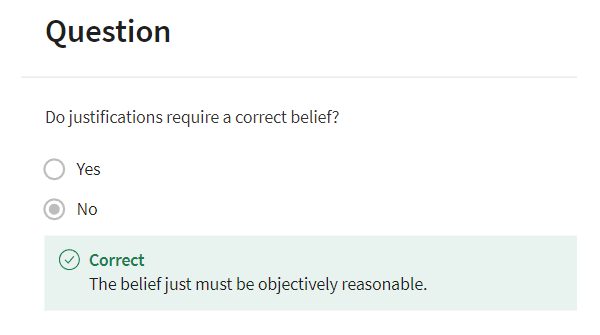
Self-defense is a perfect
example of a justification. We as a society believe that
people are justified in using intentional force to prevent immediate
wrongful aggression against them. Suppose I wrongfully threatened to kill
someone with immediate deadly force. My innocent victim would be justified in
protecting his own life with deadly force. He would be justified in
intentionally killing me, because the intentional killing of
a wrongful aggressor when there really is no alternative, is preferable to an
innocent life being taken by a wrong doer. Intentional killing is thus right, or at
least permissible under the circumstances. Imagine, for example, that Moritz, the police officer,
hated Clark and stopped him for the purpose of killing Clark, and Clark
responded more quickly to kill Moritz. If that had really happened,
Clark’s killing of Moritz would be justified self defense, and
he would be fully acquitted even though the prosecution prima facie
case could be established.
Other examples of justification
that include defense of others, and defense of property. Intentional harming of others
is considered right or permissible under limited
conditions in these situations. But, once again, what all
justifications have in common is that otherwise wrongful conduct is right,
or permissible under the circumstance. Notice that there is nothing wrong
with the defendant in these cases. The defendant was a responsible person,
and was simply doing the right or permissible thing in
the circumstances of the case. Before we turn to our discussion of
the affirmative defenses of excuse and the remaining topics in this introduction,
let us take a final break. [MUSIC]
Criminal Law: Part 4
[MUSIC] Welcome back to the final
section of this lecture. Let us begin with the affirmative
defenses of excuse.
“Affirmative defenses of excuse” 指的是在法庭上被告提出的、基于某种辩护理由的肯定性辩护。这些辩护理由通常是为了证明被告在犯罪行为时存在某种合理的、可以免责的情况,从而减轻或免除其责任。
常见的肯定性辩护理由包括自卫、紧急情况、精神失常、无能力行为、自愿放弃权利等。这些辩护理由通常要求被告提供证据来证明自己的行为在法律上是可以理解或接受的。
举例来说,如果被告因为精神失常而无法理解自己的行为,并因此而犯下了罪行,那么精神失常就是一种肯定性辩护理由。被告需要提供证据来证明自己在犯罪时处于精神失常的状态,并因此而无法控制自己的行为。
总的来说,肯定性辩护理由旨在证明被告在犯罪时具有一定的合理性或免责性,从而减轻其所面临的法律责任。
In cases of excuse, defendants have
done wrong, but they are not held accountable because we think there is some
reason that they are not responsible for what they did. In cases of justification, the defendant
is a responsible person who has done the right thing or
the permissible thing. In cases of excuse, a non-responsible
person has done the wrong thing. Examples of excuses are infancy,
insanity and duress. Understanding them requires
an explanation of what the law means by a responsible person.
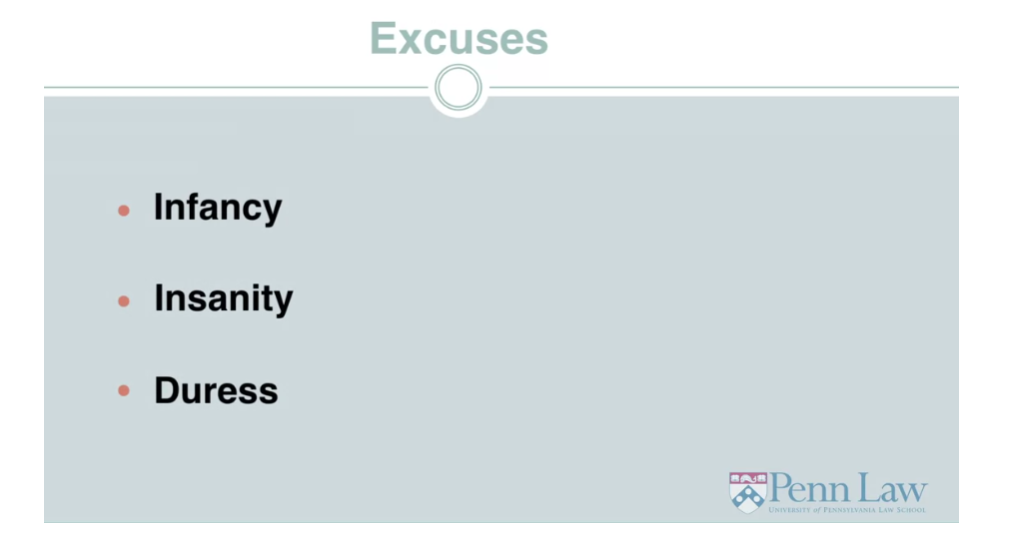
I believe that the criminal law
quite precisely agrees with the ordinary morality criteria for
responsibility and excuse. Recall our discussion of
the types of creatures we are, the types of creatures who can
rationally be guided by reason. Now think about your implicit standards
for believing that someone is the type of person, who would be
blameworthy if they did wrong. You expect such people to have
the capacity to be reasonably rational and to have acted without compulsion. If they have this rational capacity and were not compelled,
then you would consider them responsable. In contrast, if the person does not
have the capacity to be rational, or if they were compelled to act, you would
be inclined to excuse and forgive them. The criminal laws excuses
mirror these everyday criteria. We excuse young children who intentionally
do wrong, because their capacity for rationality is not fully developed. We excuse some people with mental
disorder, because the disorder undermines their capacity to act rationally
even if they are prima facie guilty. Suppose someone threatens to kill
you unless you kill someone else. If you yield to the threat and
kill the innocent third person, we might excuse your intentional killing,
because we would conclude that the threat produced such a hard compelling
choice that we couldn’t expect you not to kill and thus you are not
responsible for the intentional killing.
A particularly hard question about excuses
is raised when a wrongdoer’s capacity for rationality was seemingly fine and no one
was threatening him, but he claims that he couldn’t control himself or couldn’t
help himself when he committed the crime. Cases of addiction or
child molestation are examples. But exploring this topic of self control,
excuses is for an advanced and
not an introductory lecture. Indeed the whole issue of
excuses is theoretically and factually complex, but once again,
you must have the general idea.
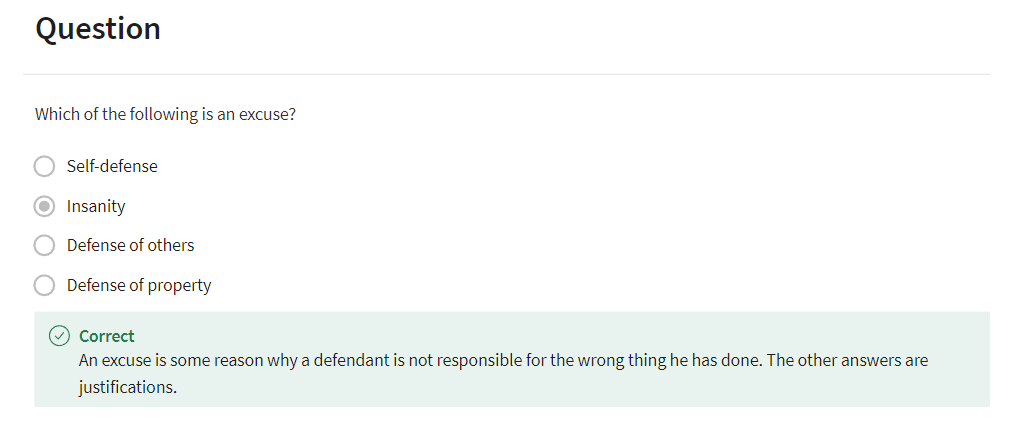
I have not previously mentioned
free will in this lecture. Free will is not a criterion for
any criminal law doctrine. And our whole system of criminal blame and
punishment, does not depend on a presumption of so called metaphysical
free will in the strong sense. That is the ability of people to act
uncaused by anything but ourselves. When we excuse, it is actually because
defendants lack rational capacity or are compelled to act, and
not because they lack free will. There is a philosophical metaphysical
debate about free will and it’s relation to responsibility
in some ultimate sense. But it is not a debate
within criminal law.
Now let us return to Eric Clark. Permit me to change the facts a bit. Supposed Clark knew Marts was a person and a police officer, but
as a result of a severe mental disorder, he delusionally believed that when Marts
stopped him, Marts was about to kill him. He therefore shot and killed Marts in the belief he needed
to do so, to save his own life. In this case he purposely took the life
of a victim, he knew was a person and a police officer, but
he acted for a crazy reason. His delusional belief,
that was a product of his disorder, rather than being caused by
his carelessness or the like. His capacity for rationality, under the
circumstances, was severely compromised, and he is a candidate for
the excuse of legal insanity.
The criteria for this excuse, and
recall that all justifications and excuses have their own criteria, are that
he was suffering from a mental disorder and, more importantly,
as a result did not know right from wrong. In this hypothetical case if we
believe him, he did suffer from a mental disorder and as a result he
didn’t know that killing Moritz was wrong. He delusionally and genuinely believed
that his own life was wrongfully in danger, and that he had a legal right
to kill Marts to save his own life. Nevertheless, it was wrong to kill Marks because
the officer was not threatening Clark. But Clark was not a responsible person
because he did not know that he was doing wrong and it was not his
fault that he made this mistake, thus he will be acquitted by reason
of the excuse of legal insanity.
Assume that its prosecution
is able to prove its case beyond a reasonable doubt and that
no affirmative defense is established. The defendant will then be found
guilty of the crime charged and deserves to be punished. At this stage we are ready for the last
part of our discussion, sentencing. The imposition of the proper punishment.
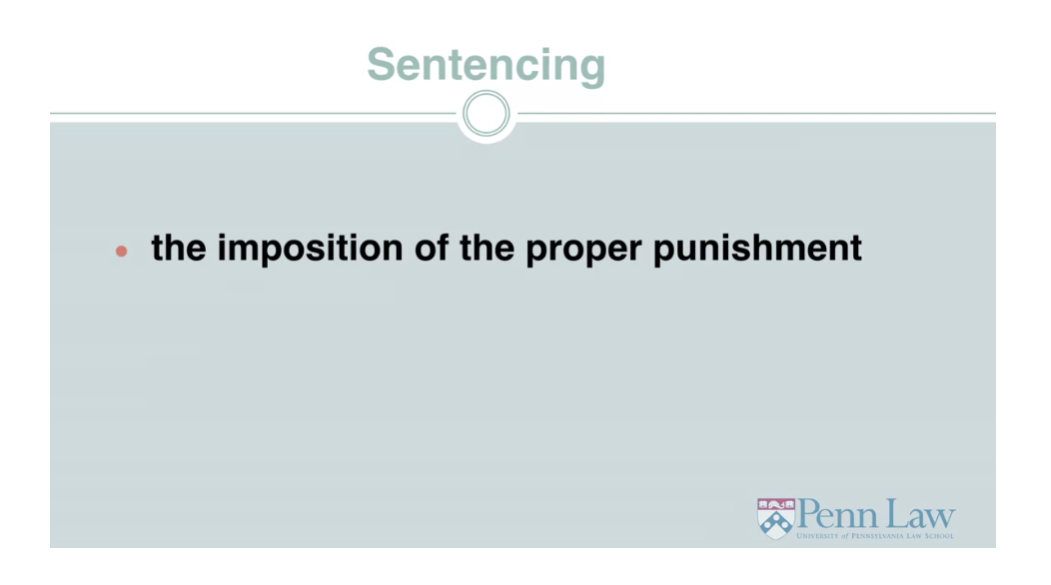
Most experienced criminal defense
attorneys will tell you that their clients care far more about whether
they will go to prison, and for how long than about whether
they are convicted. Yes, a conviction imposes blame and
stigma, but for most people, going to prison, the primary punishment in the
United States is profoundly painful and to be avoided for the many reasons
that are not difficult to imagine. Thus, the possible punishments, and
the process by which they are imposed, are of the utmost importance to
the state and to the individual. The goals of sentencing
are generally the same goals that generally justify criminal blame and
punishment. Giving offenders their just dessert and
preventing crime. But sentencing schemes are seldom
precisely clear on how these goals should be weighed and balanced in general, or how they
should be applied in individual cases. Recent decades have seen greater
emphasis on retribution and less indeterminate sentences. But the pendulum may be swinging
towards more evidence based crime control that focuses on the offenders
risk of future criminal behavior. The punishments that may be imposed for
crimes are set by the legislature, or by an administrative agency
the legislature authorizes to do this. The Supreme Court has
repeatedly held that the 8th amendments prohibition of cruel and
unusual punishments, sets almost no constraints on the terms
of years legislatures may authorize. The Supreme Court has held some
exceedingly severe sentencing schemes, such as California’s original
three strikes and you’re out law. Which permitted a sentence
of 25 years to life, for a defendant convicted of a third felony,
even if the third felony was relatively minor, and the prior
two felonies were not so serious.
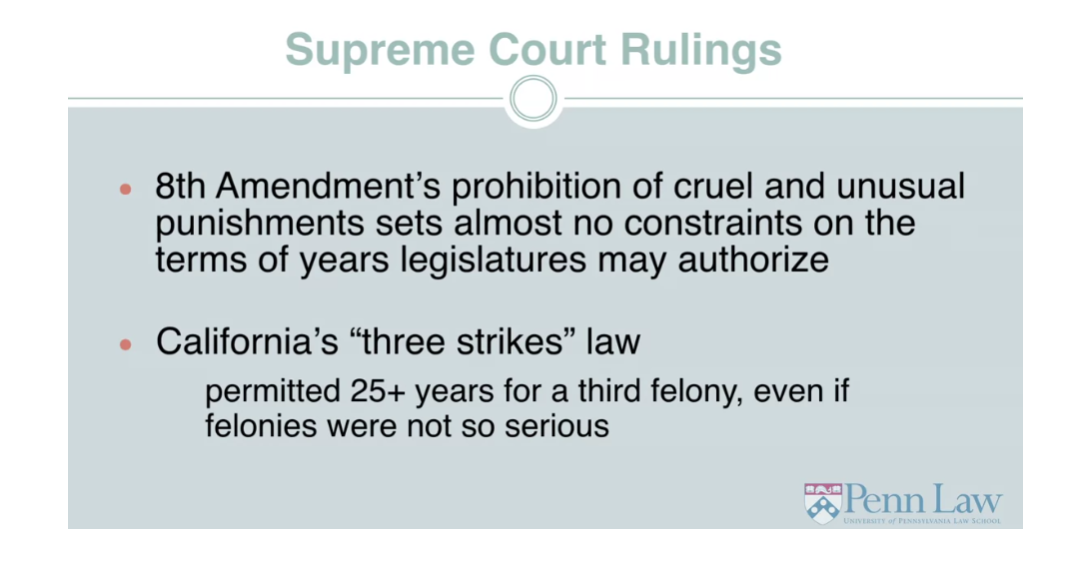
There is enormous disparity across and within jurisdictions concerning
the proper sentences for various crimes. Once again,
the federal laboratory is at work. Juries decide whether the defendant
is legally innocent or guilty, and with the primary exception of capital
sentencing, judges impose sentences. Generally, the legislature provides for
a range of sentences for each crime, but is often unclear what sentences,
retribution or crime control demand. Judges therefore, have wide
discretion to decide what sentence to impose within the statutorily
authorized range. They’re typically aided in this by
non-binding pre-sentence reports prepared by probation officers, or other court personnel that address
the defendant’s background, the circumstances of the crime, and
other sentencing considerations. In some jurisdictions, judicial discretion
is constrained by legislatively mandated guidelines, or by required mandatory
minimum sentences that must be imposed.
Despite attempts to rain
in unjustified discretion, inequality in sentencing for
similar crimes committed by similar defendants remains
a disturbing phenomenon. There has been a great deal ferment
concerning sentencing in recent decades, reflecting the recognition of how
important it is to individual lives and to the society as a whole. Everyone hopes that the attention paid and the thought given will produce a more
just and effective sentencing system. But whether that result will be
achieved is an open question.
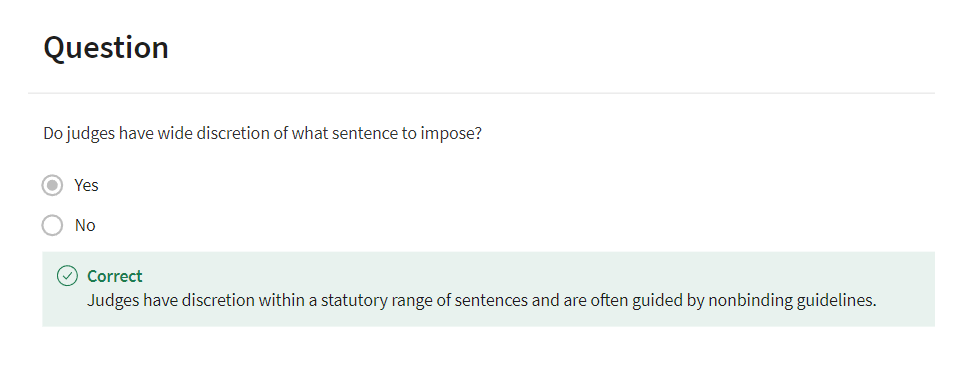
Let me conclude this section on
sentencing by pointing out another way in which the United States is distinctive. Imprisonment and fines are a common
feature across a wide range of nations, but what sets apart sentences in the
United States, compared to other developed nations, is the much greater length of
prison terms we impose for most crimes. I leave aside here, capital punishment, which among western developed nations,
only the United States imposes. Despite the controversy concerning
the moral appropriateness and crime-control effectiveness of the death
penalty, and the distinctiveness of our imposing it, it applies to so
few cases that for this lecture I will simply treat it as an example of
comparative harshness of our punishments.
Let me therefore return to the example
of imprisonment to illustrate my point about the length of sentences. Please compare Bernard Madoff, whose massive fraud harmed in impoverished
large numbers of innocent people, wiping out retirement savings and other
crucial forms of investment, and security. To Anders Breivik,
the young Norwegian ultranationalist, who killed eight people in Oslo
bombings to create a diversion, invaded a summer youth camp for members
of a political party he despised and systematically slaughtered
69 people at the camp. Madoff, who was 71 years at the old at
the time of sentencing for his fraud, received 150 years in prison for
his Ponzi scheme. Breivik, who is 32, received 21 years for
his mass murders of 77 people.
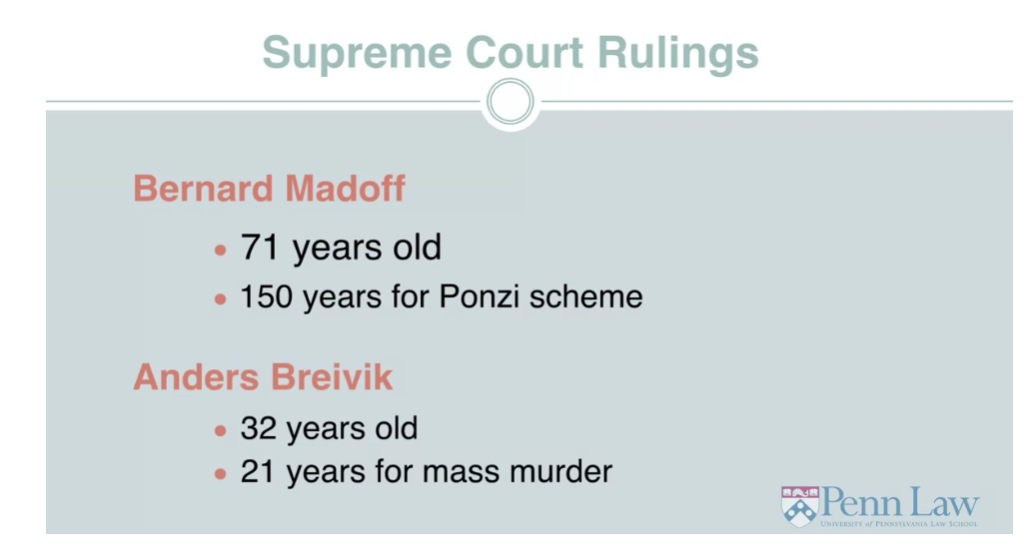
Breivik would have to serve
at least ten of the 21 years, although, he could be detained for much
longer in Norway on non-penal grounds. Non-penal grounds,
if he were found to still be dangerous. With no lack of compassion or
respect for Madoff’s victims. I can safely say that what Madoff did was
far less blameworthy and harmful, but our law permitted a vastly greater
sentence than Norwegian law provided for Breviks multiple murders. Of course, Madoff was much older and
likely to effectively serve less time, but that is beside the point. If he had been Brevick’s age the sentence
disparity would be even clearer. It goes beyond the scope of this lecture
to explain why our sentences are so comparatively severe. And I’m here taking no position on whether
such severity is justified, but it is simply a fact that sentences in the United
States tend to be comparatively severe.
Let me say a few words in conclusion
about the future of criminal law. We have covered a lot of territory. Here is a brief speculation
about the future. As we all know from
reading the newspapers and other media, there have been major
advances from the various sciences in our understanding of
the causes of human behavior. Hardly a day goes by without
a revelation from psychology, genetics, neuroscience, and other disciplines
that study human behavior. Our criminal law is based as we have
seen on our ordinary understanding of ourselves as persons. As we learn more and more about ourselves,
will we come to see ourselves as the non-responsible victims of causal
forces over which we have no control. If so, this would justify abandoning
our practices of blame and punishment that take people
seriously as moral agents. Many think that this development
is possible and even desirable. In contrast, I think that this is
highly unlikely for many reasons. And I believe that our view of
ourselves as creatures who act for and can be guided by reason,
which is the basis of criminal law and ordinary morality as, is here to stay. And it’s a good thing too. Our current concept of personhood is
at the core of concepts like liberty. Dignity and respect and concern for people that contributes
to the richness of our lives. I believe it would be a human disaster
to abandon these concepts, and there is no scientific or
moral justification for doing so. Criminal law is a complex and
fascinating topic. I hope that you found this lecture
interesting, and that it had provided you with tools to think about criminal
justice issues as concerned citizens. Thank you very much. [MUSIC]
Criminal Law Quiz
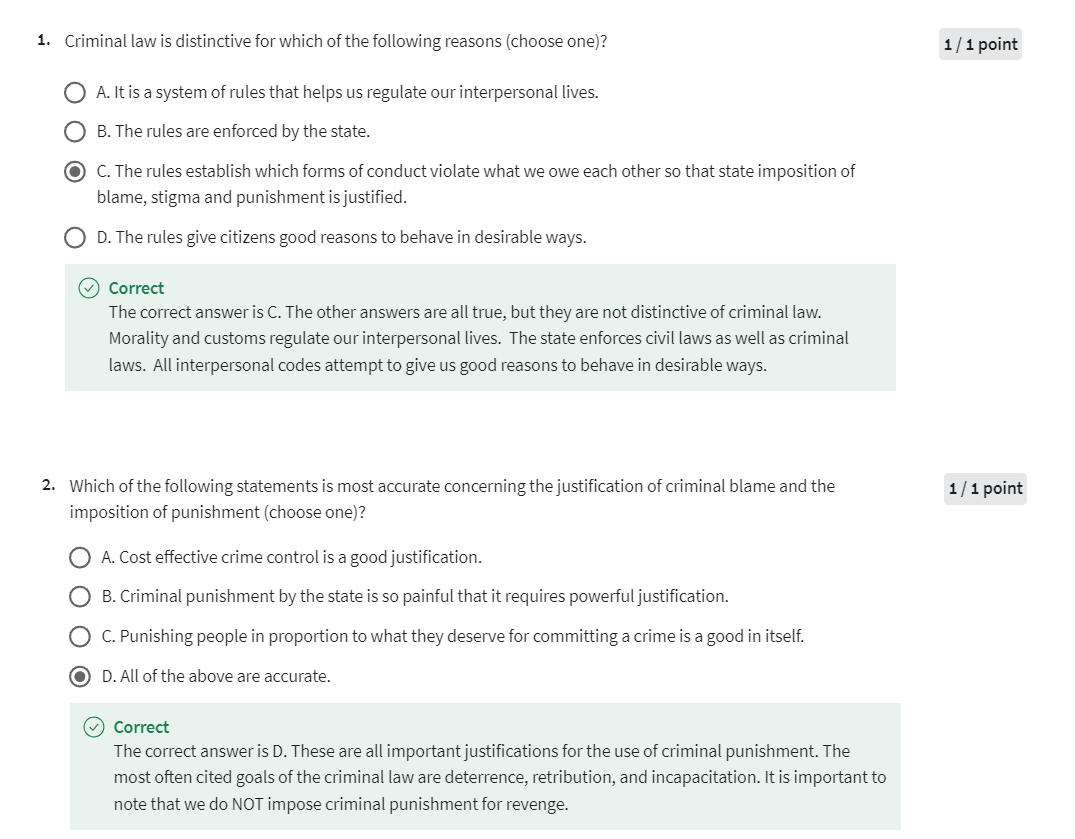
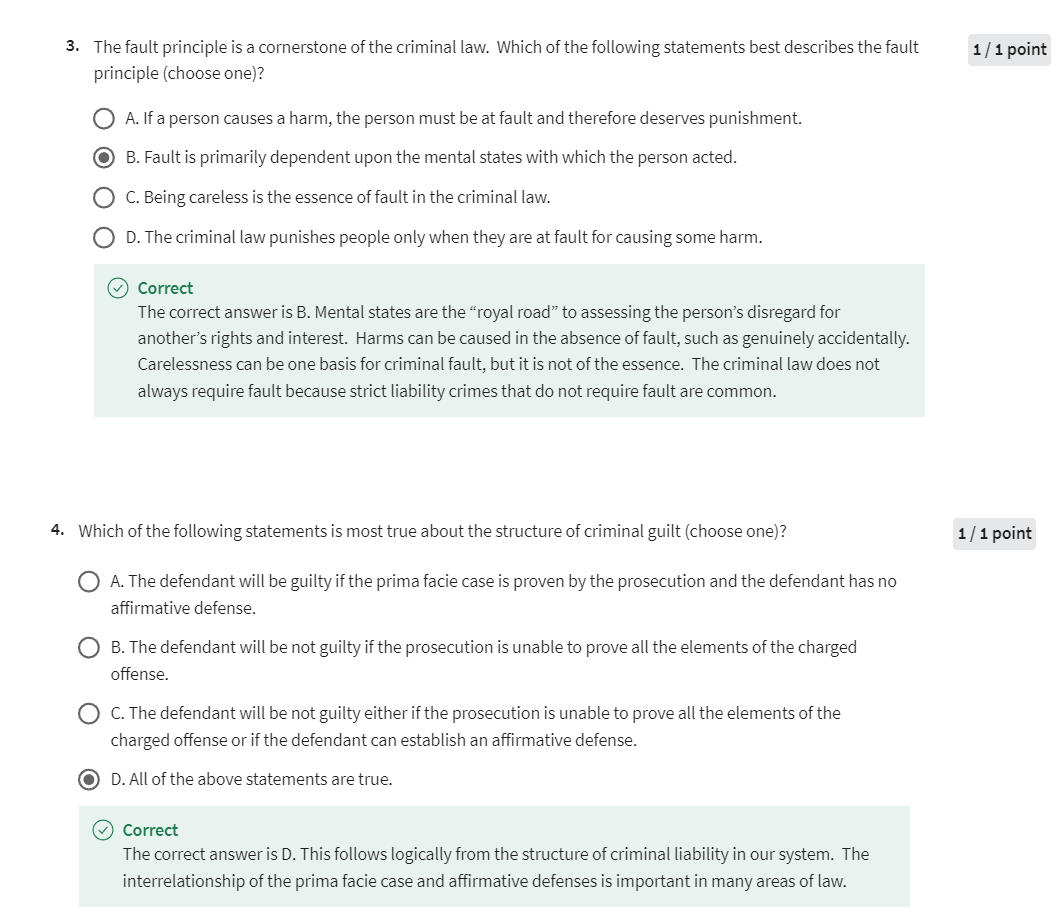
法律英语
criminal law: 刑法
forensic:美 [fəˈrenzɪk] 刑侦的,法医的
forensic psychologist:法医心理学家
touchstone:试金石;检验标准
hapless:美 [ˈhæpləs] 不幸的,运气不好的
paralyze:使瘫痪,使麻痹
quadriplegic:美 [ˌkwɑdrɪˈplidʒɪk] 四肢瘫痪的
Our driver crashes into the hapless other vehicle, killing the driver and paralyzing the passenger, who is irreversibly quadriplegic:我们的司机撞上了另一辆倒霉的车,司机死亡,乘客瘫痪,不可逆转地四肢瘫痪
province:范围,领域;省
This is the province of the criminal law.这是刑法的范围。
prosecute:美 [ˈprɑːsɪkjuːt] 起诉
criminal law is based fundamentally on moral values about what we owe each other, and then imposes state blame and punishment for the gross failures of obligation that occur all too often. 刑法基本上是基于道德价值观,即我们对彼此的亏欠,然后对经常发生的严重失职施加国家指责和惩罚。
imposition:强加,施加
stigma:耻辱,污名
infliction:美 [ɪnˈflɪkʃən] 强加,施加
State blame and punishment are the most severe impositions of state power, because they involve official public blame and stigma and the infliction of punishment 国家指责和惩罚是国家权力最严厉的强制手段,因为它们涉及官方的公开指责和指责以及施加惩罚
burden of proof:举证责任
preponderance: 优势;多数
preponderance of the evidence
“Preponderance of the evidence” 是指在法律上一种证据标准,用于评判民事案件中的证据。这一标准要求法庭在评估证据时,只需确定某一方提出的证据是否比另一方提出的证据更有说服力,即是否更可能属实。简而言之,如果证据倾向于支持某一方的主张,即使只是稍微多一点,法庭也应该裁定支持该方的主张。这种标准通常被认为是低于“超越合理怀疑”(beyond a reasonable doubt)的标准,后者通常用于刑事案件中。
acquit: 美 [əˈkwɪt] 宣告无罪
convict: 宣判有罪
We favor the error of acquitting the guilty to the error of convicting the innocent. 我们宁可判有罪的人无罪,也不愿判无罪的人有罪。
adjudication:美 [əˌdʒudɪ’keɪʃn] 判决,裁定
plea:美 [pliː] 恳求,供词,陈述(法律上的)
plea bargain:辩诉交易;认罪辩诉协议
plead guilty: 认罪
trial:审讯
Most criminal cases in the United States are disposed of by plea agreements, so-called plea bargains, by which the defendant agrees to plead guilty, thus saving the government the time, trouble, and expense of trials. 美国的大多数刑事案件都是通过认罪协议处理的,即所谓的辩诉交易,被告同意认罪,从而为政府节省了审判的时间、麻烦和费用。
retribution:应得的惩罚,报应
deserts:应得的惩罚
The technical term for the justification for inflicting blame and punishment because the defender deserves it is retribution, which is also known as just deserts. 因辩护人罪有应得而对其施加责备和惩罚的理由的专业术语是报应,也称为正义的报应。
homicide:美 [ˈhɑːmɪsaɪd] 谋杀,凶杀
arson:美 [ˈɑrs(ə)n] 纵火
Familiar examples are homicide, rape, arson, and stealing another’s property. 常见的例子有杀人、强奸、纵火和盗窃他人财产。
prostitution:美 [ˌprɑːstɪˈtuːʃn] 卖淫
Should prostitution be a crime? 卖淫应该是犯罪吗?
blameworthy: 应受谴责的
blow up:使爆炸
Suppose for example I want to blow up a plane to destroy the cargo so that I can collect insurance proceeds. 假设我想炸毁一架飞机来摧毁货物,这样我就可以获得保险金。
culpability : 美 [kʌlpəˈbɪlətɪ] 有过失,有罪
paranoid:美 [ˈpærənɔɪd] 有偏执狂特征的,妄想的
schizophrenia:美 [ˌskɪtsəˈfriːniə] 精神分裂症,人格分裂
Clark undisputedly suffered from paranoid schizophrenia:克拉克毫无疑问患有偏执型精神分裂症
infancy:幼年;婴儿期;
insanity:美 [ɪnˈsænəti] 精神错乱,精神病
duress:美 [d(j)ʊˈrɛs] 强迫,胁迫
Examples of excuses are infancy, insanity and duress:借口的例子有婴儿期、精神错乱和胁迫
child molestation :儿童性骚扰
“Child molestation” 是指对儿童进行性侵犯或性虐待的行为。这包括对未成年人进行性侵犯、性骚扰、性行为或其他不当性行为的行为。这种行为是严重的犯罪,对受害者造成长期的心理和情感伤害,因此受到法律的严厉惩罚。
felony:重罪
后记
2024年4月28日20点56分完成Week 5关于刑法的学习。今天是周日,但是五一假期调休,变成今天是工作日,上周四的课。



